Benq S680C Tri-Band Mobile Phone User Manual S660C TC EN
Benq Corporation Tri-Band Mobile Phone S660C TC EN
Benq >
Contents
- 1. Manual 1 rev
- 2. Manual 2
Manual 1 rev
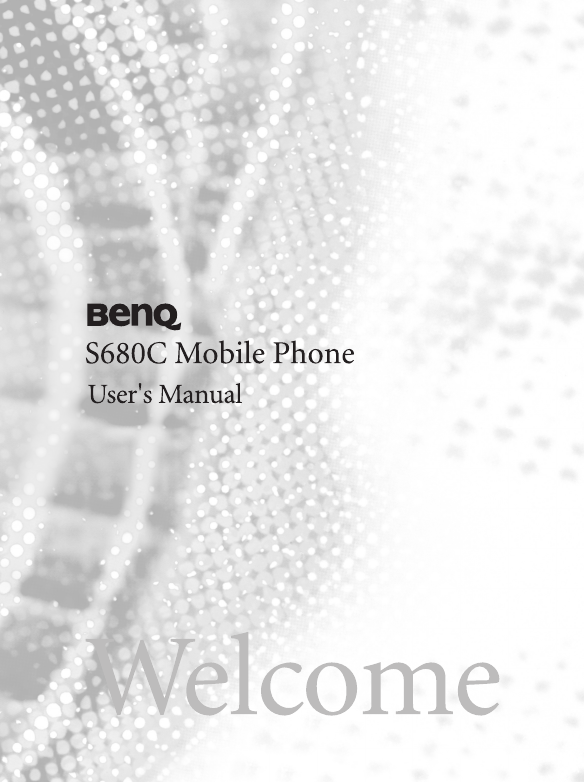

Copyright
© 2004. BENQ Corporation. All rights reserved. No part of this
publication may be reproduced, transmitted, transcribed, stored in a
retrieval system or translated into any language or computer language, in
any form or by any means, electronic, mechanical, magnetic, optical,
chemical, manual or otherwise, without the prior written permission of
BENQ Corporation.
* This publication includes images from CorelDRAW® 9 which are
protected by the copyright laws of the U.S., Canada and elsewhere. Used
under license.
Disclaimer
BENQ Corporation makes no representations or warranties, either
expressed or implied, with respect to the contents hereof and specifically
disclaims any warranties, merchantability or fitness for any particular
purpose. Further, BENQ Corporation reserves the right to revise this
publication and to make changes from time to time in the contents hereof
without obligation of BENQ Corporation to notify any person of such
revision or changes.
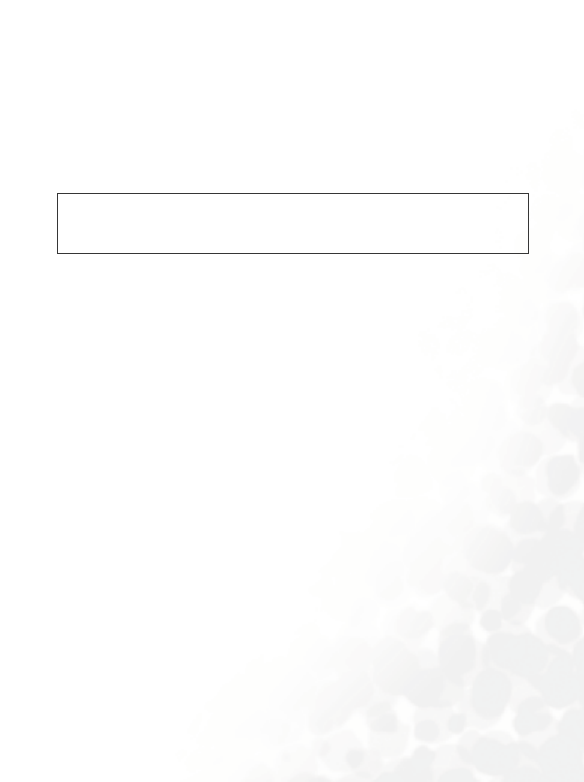
Safety Information i
Safety Information
For your safety, please read the guidelines below carefully
before you use your phone:
Exposure to Radio Frequency Signals
Your wireless handheld portable telephone is a low power transmitter and
receiver. When it is ON, it receives and also sends out radio frequency
(RF) signals.
European and international agencies have set standards and
recommendations for the protection of public exposure to RF
electromagnetic energy.
•International Commission on Non-Ionizing Radiation Protection
(ICNIRP) 1996
•Verband Deutscher Elektringenieure (VDE) DIN- 0848
•Directives of the European Community, Directorate General V in
Matters of Radio Frequency Electromagnetic Energy
•National Radiological Protection Board of the United Kingdom, GS 11,
1988
•American National Standards Institute (ANSI) IEEE. C95.1- 1992
•National Council on Radiation Protection and Measurements (NCRP).
Report 86
•Department of Health and Welfare Canada. Safety Code 6
These standards are based on extensive scientific review. For example,
over 120 scientists, engineers and physicians from universities,
government health agencies and industry reviewed the available body of
research to develop the updated ANSI Standard.
The design of your phone complies with these standards when used
normally.
Max. SAR measurement
EU: GSM900: 0.795 mW/g; DCS1800: 0.504 mW/g.
USA: PCS1900: 0.557 mW/g.

ii Safety Information
Specific Operating Restrictions
No metallic component allowed in body-worn accessories.
Antenna Care
Use only the supplied or approved replacement antenna. Unauthorized
antennas, modifications or attachments may damage the phone and
violate FCC regulations.
Phone Operation
Normal Position: Hold the phone as you would any other telephone with
the antenna pointed up and over your shoulder.
For your phone to operate most efficiently, do not touch the antenna
unnecessarily when the phone is in use. Contact with the antenna affects
call quality and may cause the phone to operate at higher power level than
otherwise needed.
Batteries
All batteries can cause property damage, injury or burns if a conductive
material such as jewelry, keys or beaded chains touches exposed terminals.
The material may complete electrical circuit and become quite hot. To
protect against such unwanted current drain, exercise care in handling any
charged battery, particularly when placing it inside your pocket, purse or
other container with metal objects. When battery is detached from the
phone, your batteries are packed with a protective battery cover; please
use this cover for storing your batteries when not in use.
Driving
Check the laws and regulations on the use of wireless telephones in the
areas where you drive. Always obey them. Also, if using your phone while
driving, please:
•Give full attention to driving--driving safety is your first responsibility.
•Use hands-free operation, if available.

Safety Information iii
•Pull off the road and park before making or answering a call if driving
conditions so require.
Electronic Devices
Most modern electronic equipment is shielded from RF signals. However,
certain electronic equipment may not be shielded against the RF signals
from your wireless phone.
Pacemakers
The Health Industry Manufacturers Association recommends that a
minimum separation of six (6") inches be maintained between a handheld
wireless phone and a pacemaker to avoid potential interference with the
pacemaker. These recommendations are consistent with the independent
research by and recommendations of Wireless Technology Research.
Persons with pacemakers:
•Should ALWAYS keep the phone more than six inches from their
pacemaker when the phone is turned ON.
•Should not carry the phone in a breast pocket.
•Should use the ear opposite the pacemaker to minimize the potential for
interference.
If you have any reason to suspect that the interference is taking place, turn
your phone OFF immediately.
Hearing Aids
Some digital wireless phones may interfere with some hearing aids. In the
event of such interference you may want to consult your hearing aid
manufacturer to discuss alternatives.
Other Medical Devices
If you use any other personal medical device, consult the manufacturer of
your device to determine if they are adequately shielded from external RF
energy. Your physician may be able to assist you in obtaining this
information.

iv Safety Information
Turn your phone OFF in health care facilities when any regulations posted
in these areas instruct you to do so. Hospitals or health care facilities may
be using equipment that could be sensitive to external RF energy.
Vehicles
RF signals may affect improperly installed or inadequately shielded
electronic systems in motor vehicles. Check with the manufacturer or its
representative regarding your vehicle. You should also consult the
manufacturer of any equipment that has been added to your vehicle.
Posted Facilities
Turn your phone OFF in any facility where posted notice so requires.
Aircraft
FCC regulations prohibit using your phone while in the air. Switch OFF
your phone before boarding an aircraft.
Blasting Areas
To avoid interfering with blasting operations, turn your phone OFF when
in a “blasting area” or in area posted “TURN OFF TWO-WAY RADIO.”
Obey all signs and instructions.
Potentially Explosive Atmospheres
Turn your phone OFF and do not remove the battery when in any area
with a potentially explosive atmosphere and obey all signs and
instructions. Sparks, from your battery, in such areas could cause an
explosion or fire resulting in bodily injury or even death.
Areas with a potentially explosive atmosphere are often, but not always
clearly marked. They include fueling areas such as gasoline stations; below
deck on boats; fuel or chemical transfer or storage facilities; vehicles using
liquefied petroleum gas (such as propane or butane); areas where the air
contains chemicals or particles, such as grain, dust, or metal powders; and
any other area where you would normally be advised to turn off your
vehicle engine.

Safety Information v
For Vehicles Equipped with an Air Bag
An air bag inflates with great force. DO NOT place objects, including both
installed or portable wireless equipment, in the area over the air bag or in
the air bag deployment area. If in-vehicle wireless equipment is
improperly installed and the air bag inflates, serious injury could result.
This device complies with Part 15 of the FCC Rules.
Operation is subject to the following two conditions:
1. this device may not cause harmful interference, and
2. this device must accept any interference received, including
interference that may cause undesired operation.
European Union Directives Conformance Statement
This device complies with the OJ-Directive as below:
3GPP TS 51.010-1
EN 301 511
EN 30360/ EN30361
ETSI EN 301 489-1/-7
EN 60950
Electromagnetic Compatibility Directive (89/336/EEC), Low Voltage
Directive (73/23/EEC)
And R&TTE Directive (99/05/EEC).
And also complies with the standard:

vi Safety Information
IMPORTANT NOTE:
FCC Radiation Exposure Statement:
This equipment complies with FCC radiation exposure limits set forth
for an uncontrolled environment. This equipment should be installed
and operated with minimum distance 1.5 cm between the radiator &
your body.
This transmitter must not be co-located or operating in conjunction
with any other antenna or transmitter.

viiTable of Contents
Table of Contents
Safety Information ...........................................................i
1. Preparing Your Phone For Use................................... 1
Inserting a SIM Card............................................................ 1
Installing a Battery and Charging the Phone ...................... 2
Turning the Phone On......................................................... 5
2. Getting to Know Your Phone .....................................7
Your Phone at a Glance........................................................ 7
Active Flip Feature.............................................................. 10
Status Indicator Light......................................................... 10
Standby Screen.................................................................... 11
External Display .....................................................................11
Icons in the External Display's Status Bar.............................12
Main Screen ............................................................................14
Icons in the Main Display's Status Bar..................................16
Using the Keys in the Standby Mode ....................................18
Menu Navigation................................................................ 23
Main menu map.....................................................................30
3. Using Your Phone ..................................................... 33
Making a Phone Call .......................................................... 33
Ending a Phone Call........................................................... 33
Answering a Phone Call ..................................................... 34
Rejecting an Incoming Call................................................ 35
Turning Off the Ring Tone
for an Incoming Call .......................................................... 35

viii Table of Contents
Making an International Call............................................. 35
Making an Emergency Call ................................................ 36
Dialing an Extension Number ........................................... 36
Speed Dialing ...................................................................... 36
Voice Dialing ...................................................................... 36
Listening to Voicemails...................................................... 37
Phone Book......................................................................... 38
Adding Contacts to the Phone Book.....................................38
Finding Contacts in the Phone Book ....................................43
Last Missed, Dialed, and Received Calls............................ 45
Operations During a Call................................................... 47
Call Menu ........................................................................... 49
Using the Silent Profile....................................................... 51
Camera Function................................................................ 52
Shortcuts Menu .................................................................. 57
Setting Function Shortcuts ....................................................57
Setting Phone Number Shortcuts..........................................59
Using Function and Phone Number Shortcuts ....................60
Messages Menu................................................................... 61
Create ......................................................................................63
Short Message..............................................................................63
MMS ............................................................................................66
SIM Folder ..............................................................................71
Inbox .......................................................................................72
Template .................................................................................77
SMS Template .............................................................................77
MMS Template ...........................................................................77

ixTable of Contents
Outbox ....................................................................................77
Drafts.......................................................................................78
Voicemail ................................................................................79
Message Settings .....................................................................79
Cleanup Messages...................................................................84
Memory Status .......................................................................84
Voice Memo........................................................................ 85
Input Modes ....................................................................... 86
Changing the Text Input Mode.............................................86
Letter Input Mode (ABC) ......................................................87
Numeric Input Mode (123)...................................................87
Predictive Input Mode (iTap) ...............................................87
Symbol Input Mode ...............................................................89
Direct Connection to URLs ............................................... 90
4. Menus.........................................................................92
Phone Book......................................................................... 92
Find .........................................................................................92
Add..........................................................................................92
Edit ..........................................................................................92
Copy ........................................................................................93
Delete ......................................................................................93
Caller Groups..........................................................................93
Privacy Manager.....................................................................94
Business Card .........................................................................96
Activate ...................................................................................97
My Number ............................................................................97
SIM Status...............................................................................97

xTable of Contents
Call Records ........................................................................ 98
Missed Calls ............................................................................98
Received Calls .........................................................................98
Dialed Calls.............................................................................98
Delete All.................................................................................98
Call Duration..........................................................................99
Call Cost................................................................................100
Messages............................................................................ 101
Organizer .......................................................................... 102
Calendar................................................................................102
To Do List .............................................................................104
Note.......................................................................................105
Tools.................................................................................. 105
Camera..................................................................................105
Alarm Clock..........................................................................106
Shortcuts ...............................................................................107
Voice Memo .........................................................................107
Calculator..............................................................................108
Currency Converter .............................................................108
Stopwatch .............................................................................110
Countdown Timer ...............................................................110
Memory Status .....................................................................111
Service Number ....................................................................111
SIM Toolkit Menu................................................................111
Games................................................................................ 112
Champion Soccer .................................................................112
Dragon Fight.........................................................................117

xiTable of Contents
Internet.............................................................................. 118
WAP Service .........................................................................118
Start Browser............................................................................. 119
WAP Message............................................................................125
Enter Address ............................................................................125
Resume ......................................................................................125
Clear Cache ...............................................................................125
WAP Settings.............................................................................125
JAVA .....................................................................................129
Multimedia ....................................................................... 133
Picture...................................................................................133
Animation.............................................................................134
Melody ..................................................................................134
My Melodies..............................................................................134
Composer .................................................................................. 136
Help ...........................................................................................139
Album ...................................................................................139
Settings .............................................................................. 144
Date & Time .........................................................................144
Time...........................................................................................144
Format ....................................................................................... 144
Secondary Time........................................................................145
Power On/Off .......................................................................145
Profiles ..................................................................................146
Display ..................................................................................150
Theme........................................................................................ 150
Wallpaper .................................................................................. 150
Welcome Message.....................................................................151
Contrast .....................................................................................152
Brightness .................................................................................. 152

xii Table of Contents
Backlight Setting .......................................................................152
OLED Duration.........................................................................152
OLED Animation Setting .........................................................153
Audio.....................................................................................153
Power Saving Mode..............................................................153
Call Settings ..........................................................................154
Call Divert .................................................................................154
Call Barring ...............................................................................155
Call Waiting...............................................................................156
Auto Redial................................................................................156
Show Number ...........................................................................156
Fixed Dial Number ...................................................................157
Active Line.................................................................................157
Connect Alert ............................................................................157
Minute Beep ..............................................................................158
Network ................................................................................158
Mode Selection..........................................................................158
Available List .............................................................................158
Band Setting ..............................................................................159
Connection Mode .....................................................................159
Security .................................................................................159
PIN Code...................................................................................159
Phone Lock................................................................................160
SIM Lock ...................................................................................161
Screen Lock ...............................................................................161
Language ...............................................................................162
Input Mode...........................................................................162
Flip Activate..........................................................................162
User Group ...........................................................................163
Restore ..................................................................................163

xiiiTable of Contents
5. Care and Maintenance ............................................ 164
6. Troubleshooting...................................................... 165

xiv Table of Contents
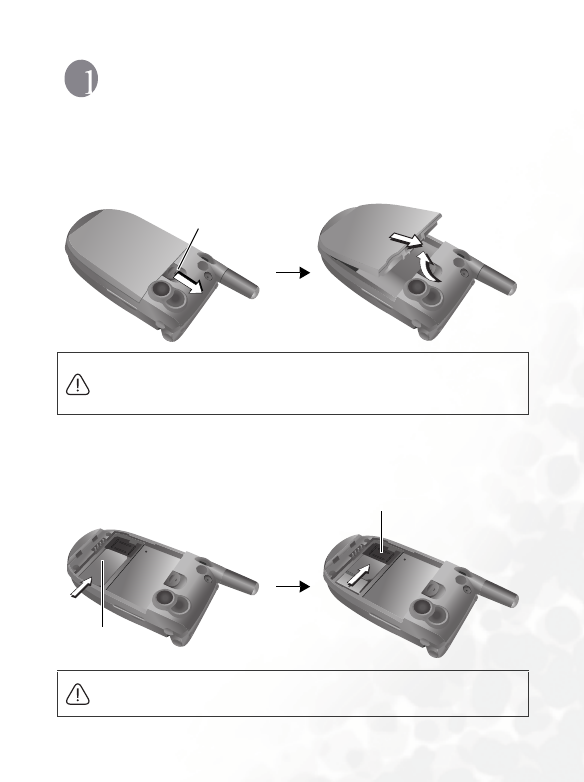
Preparing Your Phone For Use 1
Preparing Your Phone For Use
Inserting a SIM Card
1. Turn the phone over, and release the battery latch. Lift the battery off
the phone.
2. Slide the SIM card in under the metal plate in the SIM card slot, with
the SIM card's metal contacts facing down and the cut corner at the
top right.
Do not remove the battery when the phone is on. Doing so could
cause you to lose personal settings or data stored either on your SIM
card or in the phone's memory.
A SIM card can be easily damaged if its metal contacts become
scratched. Therefore, take special care when holding or inserting it.
Battery latch
SIM card
Metal plate
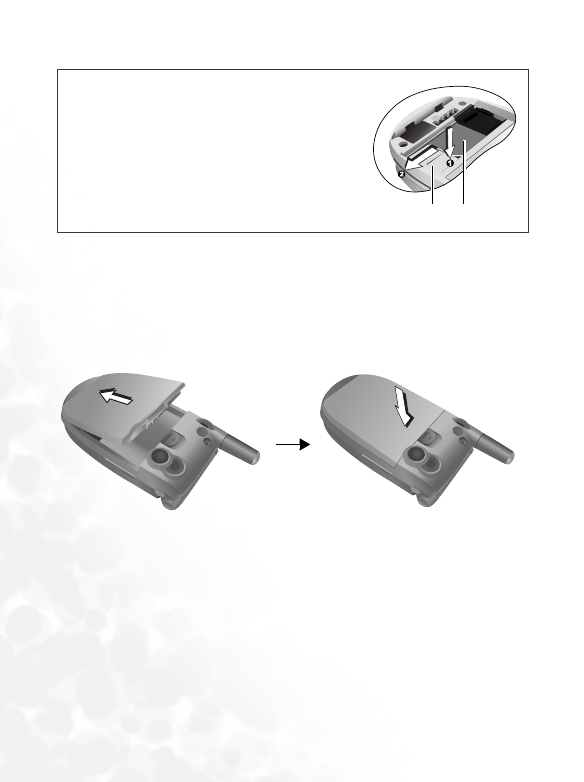
2Preparing Your Phone For Use
Installing a Battery and Charging the Phone
1. With the battery's metal contacts facing down, align the protruding
tabs on the end with the holes in the battery bay of the phone. Then
push the battery toward the end of the bay to insert the battery's tabs
into the holes. Press down to click the battery in place.
/If you wish to remove the SIM card, you
must first press down the stay, then push
the SIM card out of the slot.
Stay SIM card
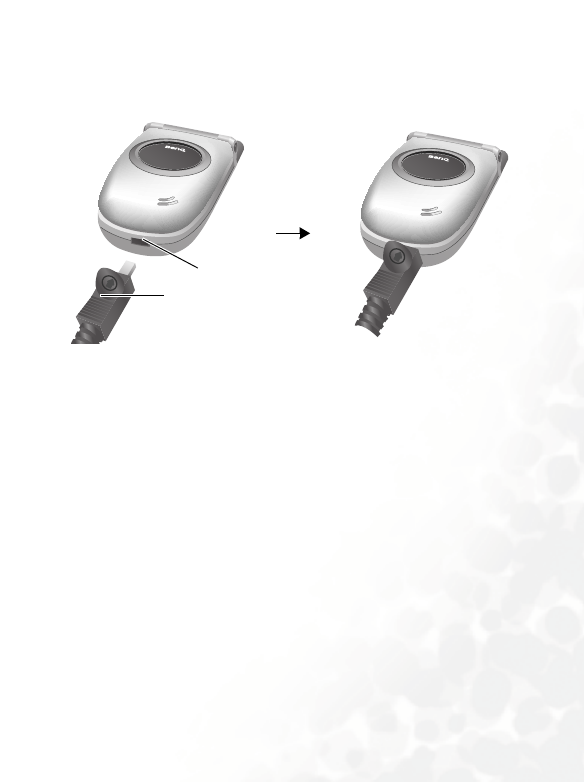
Preparing Your Phone For Use 3
2. Insert the charger connector into the charger socket on the bottom of
the phone. Make sure that the connector is inserted in the correct
orientation (with the arrow pointing up).
3. Insert the charger into a power outlet.
4. Once the phone is fully charged, remove the charger from both the
power outlet and the phone.
Charger connector
Charger socket
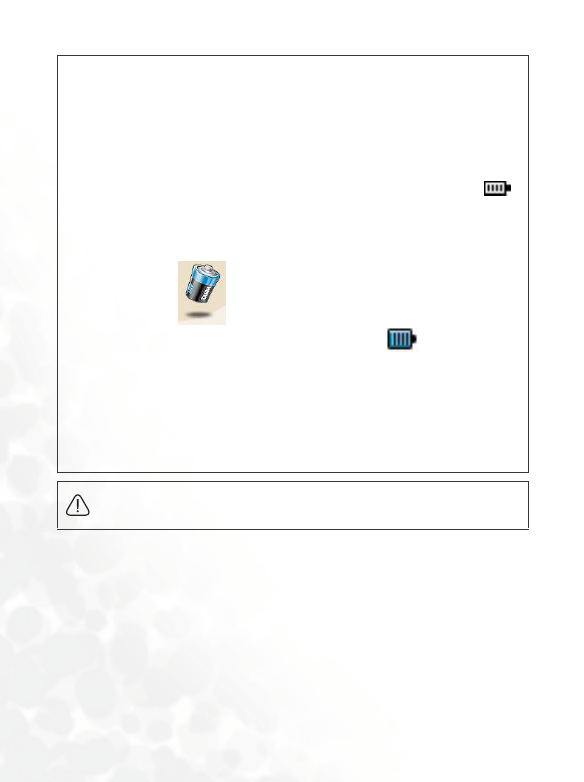
4Preparing Your Phone For Use
/•Charging requires approximately 4 hours.
•When charging the phone while it is turned off, the external and
main displays will be activated, and the status indicator light will
flash blue (during the charging process, the external display will
show the time and cycle through 3 animations, then turn off
temporarily. This is normal.
•During charging, in the external display's battery indicator ,
the lines showing the battery power level will scroll until the battery
is fully charged.
•When charging while the phone is turned off, the main display
shows the animation. If the charging is performed while the
phone is on, the main display shows the icon. The lines
showing the battery power level will scroll until the battery is fully
charged.
•After the battery is fully charged, the status indicator light will flash
purple.
•When the battery is out of power, the phone will play an alert sound
to remind you to recharge it and then will automatically turn off.
Do not remove the battery while the phone is charging.
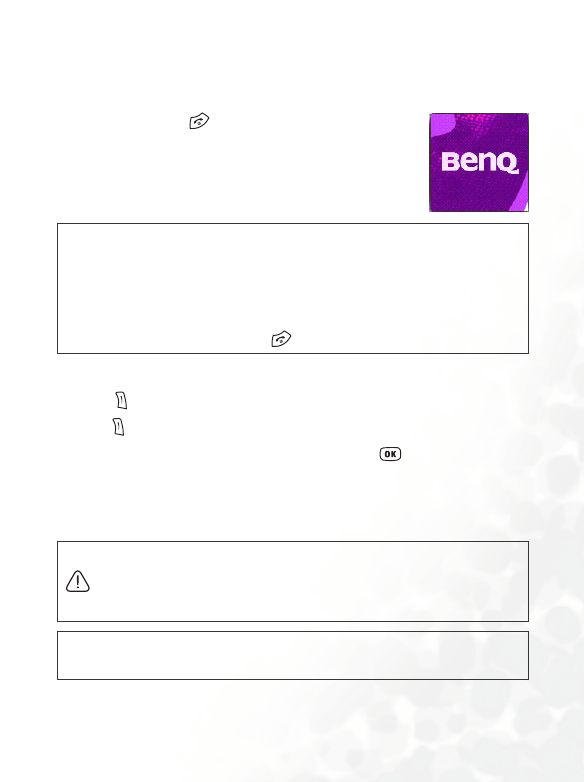
Preparing Your Phone For Use 5
Turning the Phone On
1. Open the phone's flip.
3. Enter your PIN1 number. If you enter the PIN1 number incorrectly,
press (Clear) to delete the incorrect numerals. Press and
hold to delete all numerals that have been entered. After
completing entry of your PIN1 number, press to confirm.
8The PIN (Personal Identification Number) is a password provided by
a network operator with a SIM card. You need this password in order
to use the SIM card.
/•You can select and set a welcome animation, image, or message
that will display when you turn on your phone, as well as the music
that will be played. Go to the menu: Settings → Display →
Welcome Message. For details, please refer to page 151.
•If the welcoming music goes on too long, once the standby screen
comes up, you can press to stop playback.
If you enter the PIN incorrectly 3 times in a row, the SIM card will lock
down and no longer be usable. If this happens, you must enter the
PUK (Personal Unblocking Key) for that SIM card in order to unlock
it. Please contact your network operator to obtain a PUK.
/To cancel PIN password authentication, go to the menu Settings →
Security → PIN Code → PIN1 Code. Please see page 159.
2. Press and hold to turn the phone on. The
phone will display the welcome animation.
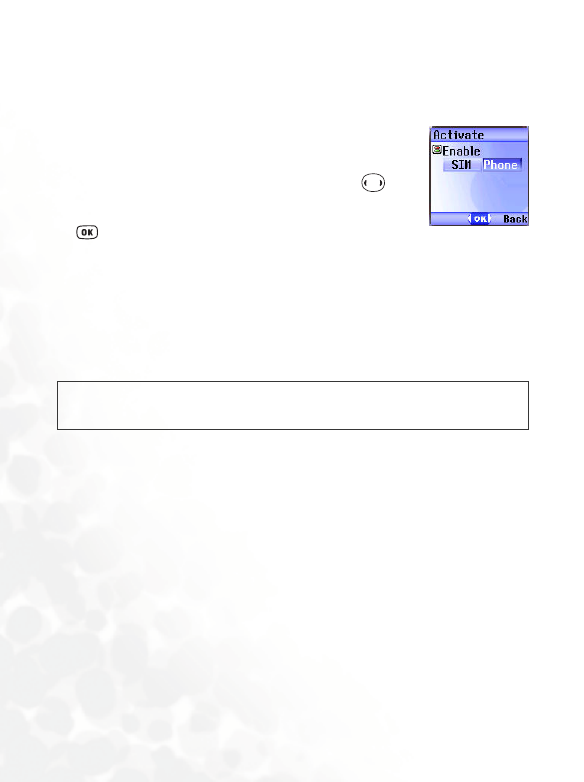
6Preparing Your Phone For Use
4. When the PIN code entered has been accepted, the phone will
automatically search for the designated network. This search process
may take a few seconds.
6. After you open the phone book on the SIM card, any data you
browse, store, or delete will be from the SIM card's phone book. If
you open the phone book in the phone's memory, any data that you
view, store, or delete will be from the phone's phone book.
7. The standby screen will be displayed, as well as network signal
strength and the name of the network operator. You can now use the
phone.
8If the phone cannot detect the network, the on-screen signal strength
meter will show no bars.
8If the phone links to a network that you are not authorized to use, the
signal strength meter will show a level of zero. You will only be able to
make emergency calls.
/If at some later point, you wish to switch phone books, go to the
following menu Phone Book → Activate.
5. The phone will then ask you whether you wish to
activate the phone book stored in the phone's
memory or on your SIM card. Press to
highlight the desired phone book and then press
to open the phone book you have selected.
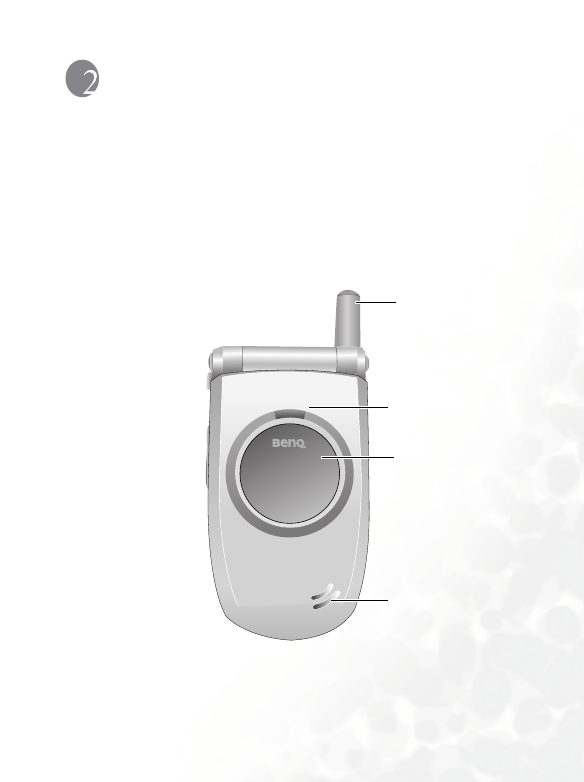
Getting to Know Your Phone 7
Getting to Know Your Phone
Your Phone at a Glance
The figure below shows the main parts of your phone:
Front view 1
External speaker
External display
Antenna
Status indicator light
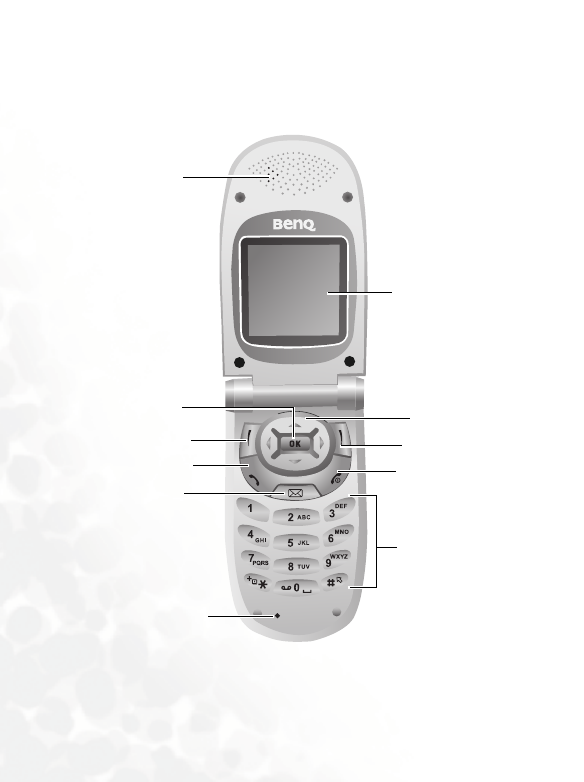
8Getting to Know Your Phone
Front view 2
Earpiece
Main display
Microphone
Right soft key
Scroll key
OK key
Dial/Answer key
Alphanumeric keys
Power on/off key
Messages menu key
Left soft key
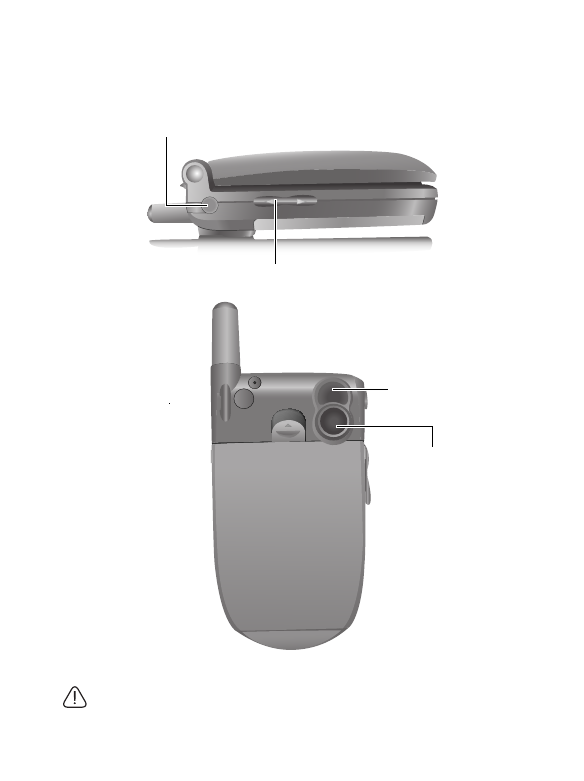
Getting to Know Your Phone 9
Side and back views
Hands-free headset/Data cable jack
Volu me key
Lanyard hole
Camera lens
Mirror used to take
self photos
To avoid potential RF interference, and please keep the minimum
distance with 15mm.

10 Getting to Know Your Phone
Active Flip Feature
Opening the flip allows you to answer an incoming call. Closing the flip
ends a call, cancels dialing, or rejects an incoming call.
Status Indicator Light
The status indicator light has the following functions:
•Flashes blue when the phone detects a network or is charging.
•Flashes purple when the battery is fully charged.
•Flashes blue rapidly when there is an incoming call.
8To turn off the status indicator light, you must start up the power
saving mode. Go to this menu: Settings → Power Saving Mode.
/You can turn the active flip feature on or off. To do so, go to the menu:
Settings → Flip Activate.

Getting to Know Your Phone 11
Standby Screen
External Display
When the flip is closed, the external display's status bar will show icons
for network signal strength, battery power, and alarm (if active). The
current time and an animation will appear in sequence. The external
display can also alert you to incoming calls, text messages, and missed
calls.
/•If you wish to set the time shown on the external display, go to the
menu Settings → Date & Time → Time. See page 144.
•In the default setting, the external display will show the time and
several animations in sequence for one cycle. The external display
will then temporarily power off. After it has powered off, you can turn
it back on by pressing either the up or down arrow on the volume
key located on the left side of the phone.
•You can set the external display's cycling mode by using the menu
Settings → Display → OLED Duration. See page 152.
•You can choose the animations to be shown on the external display
by using the menu: Settings → Display → OLED Animation
Setting. See page 153.
•You can go to the menu Settings → Profiles → Personal to
change the name of the profile to your own user name. When this
profile is activated and the phone's flip is opened, your own name
will appear on the external display. For details, see page 147.
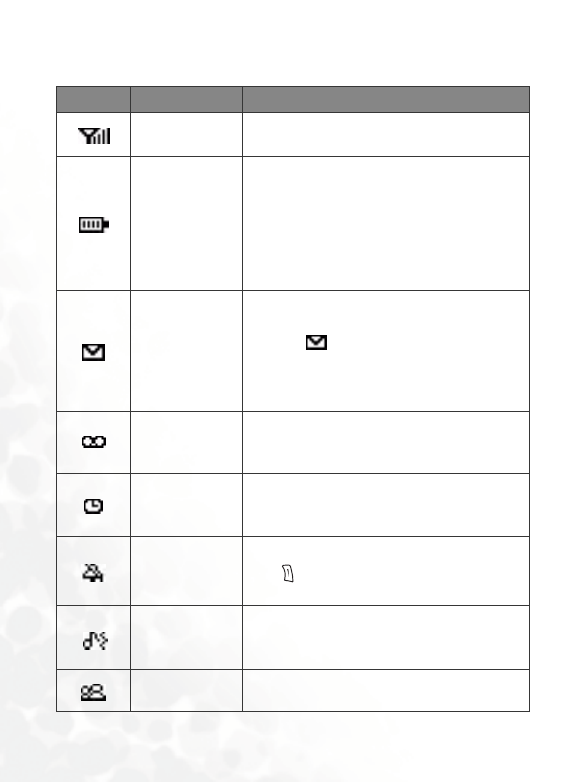
12 Getting to Know Your Phone
Icons in the External Display's Status Bar
Icon Function Description
Signal strength Signal strength of the network. The more
bars indicated, the stronger the signal.
Battery status
Shows the current level of battery power.
The more bars indicated, the more power
that remains. Four bars: fully charged. No
bars: immediate charging needed. When
charging the phone, the icon will scroll
through the bars until the battery is fully
charged.
Text message
Shows that a text message is being received
or that there are unread text messages. If
the icon flashes, this indicates that the
SIM card's text message memory is full. For
information about the text message function,
see page 61, "Messages Menu".
Voicemail
Indicates that there are voicemails (this icon
will only appear if the function is supported
by your network vendor).
Alarm
The alarm is turned on. To set the alarm, go
to the menu Tools → Alarm Clock. See
page 106.
Vibrating alert
In the standby screen, press and hold down
the key to activate the vibrating alert.
See page 51, "Using the Silent Profile".
Normal
Shows that the Normal profile is in use. To
set the profile, go to this menu: Settings →
Profiles. See page 146.
Meeting Shows that the Meeting profile is in use.
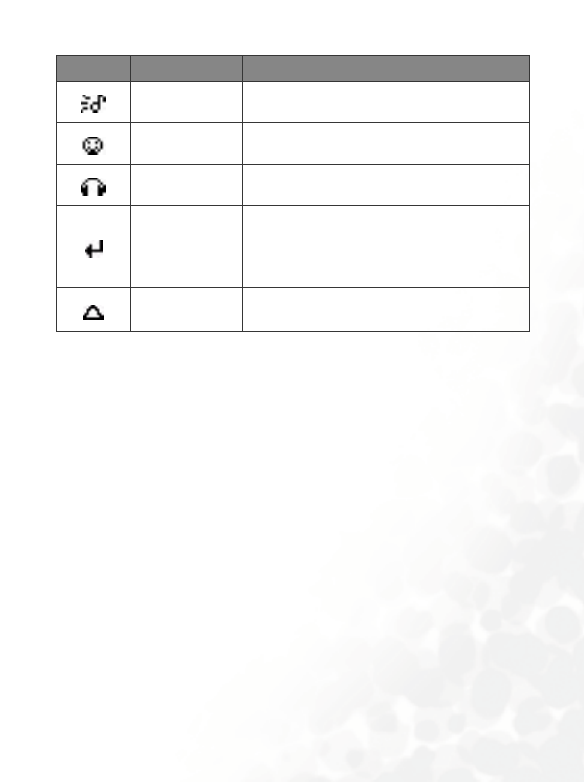
Getting to Know Your Phone 13
Outdoors Shows that the Outdoors profile is in use.
Personal Shows that the Personal profile is in use.
Handsfree Shows that the Handsfree profile is in use.
Divert
Shows that the call divert function is
active.To set the call divert function go to the
menu Settings → Call Settings → Call
Divert. See page 154.
Roaming Roaming has been activated (not your
regular network)
Icon Function Description
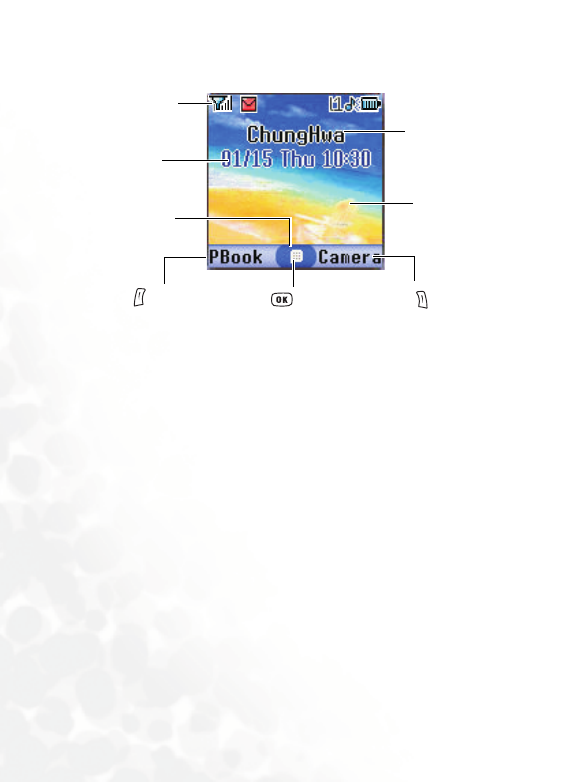
14 Getting to Know Your Phone
Main Screen
Time and date
Status bar
Name of network
operator
Soft key bar Wallpap er
Press to enter
the Phone Book
Press to use the
camera function.
Press to enter
the main menu.

Getting to Know Your Phone 15
/•You can set the animation or image you wish to use as wallpaper
when the phone is in standby mode by going to the menu
Multimedia → Picture or Animation. Alternatively, you can go to
the menu Settings → Display → Wallpaper. See page 133 and
page 150.
•To set the current time and date, as well as the format in which they
will be shown in the main display's standby screen, go to the menu
Settings → Date & Time. See page 144.
•You can go to the menu Settings → Profiles → Personal to
change the name of the profile to your own user name. When this
profile is activated, your own name will appear in the standby
screen on the main display. For details, see page 147.
•For enhanced security, you can use the screen lock function. Go to
the menu Settings → Security → Screen Lock. If the screen lock
is activated, and you have not performed any tasks with the phone
for a set time, the phone will automatically bring up the screen lock
image. The purpose is to protect any personal data on your phone
from being read by other persons. To restore the original display
screen, you must enter a password that you provide for this
function. For details on settings, see page 161.
•After the standby screen remains for 10 seconds, the soft key bar,
time and date, as well as all the other words currently displayed will
automatically disappear, showing the full-screen wallpaper. You can
also press to display/hide the status bar and words normally
shown on the standby screen.
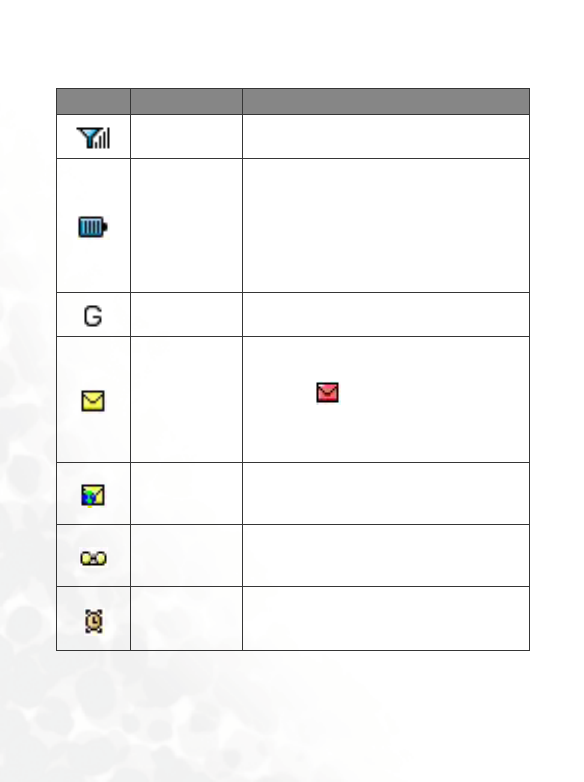
16 Getting to Know Your Phone
Icons in the Main Display's Status Bar
Icon Function Description
Signal strength Signal strength of the network. The more
bars indicated, the stronger the signal.
Battery status
Shows the current level of battery power.
The more bars indicated, the more power
that remains. Four bars: fully charged. No
bars: immediate charging needed. When
charging the phone, the icon will scroll
through the bars until the battery is fully
charged.
GPRS network GPRS services have been activated on your
SIM card.
Message
Shows that an SMS/MMS message is being
received or that there are unread messages.
If the icon appears in red, this indicates
that the SIM card's text message memory is
full. For information about the message
function, see page 61, "Messages Menu".
WAP message
You've got a WAP message (this icon will
only appear when there are no incoming or
unread SMS/MMS messages).
Voicemail
Indicates that you have voicemail messages
(this icon will only appear if the function is
supported by your network operator).
Alarm
The alarm is turned on. To set the alarm, go
to the menu Tools → Alarm Clock. See
page 106.
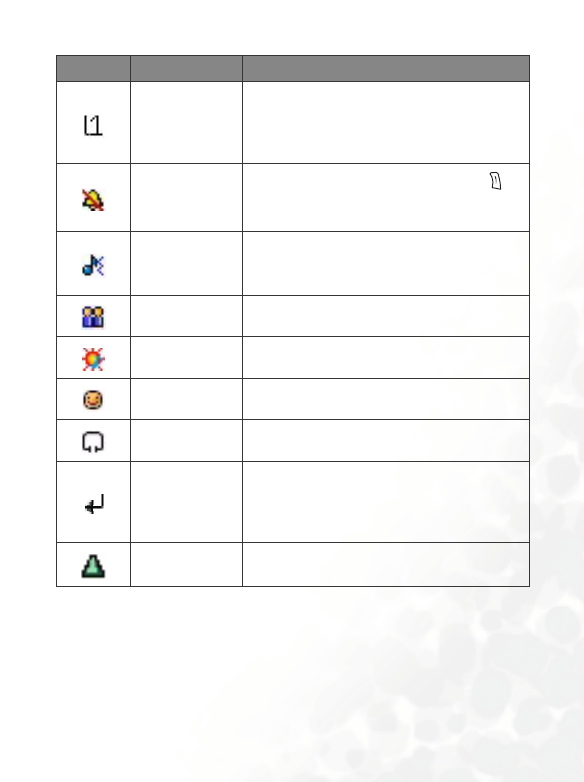
Getting to Know Your Phone 17
Line in use
Shows the number of the line currently in
use. To set the line, go to the menu Settings
→ Call Settings → Active Line. For details,
see page 157.
Vibrate
In the standby screen, press and hold to
activate the silent profile. See page 51,
"Using the Silent Profile".
Normal
Shows that the Normal profile is in use. To
set the operating mode, go to the menu
Settings → Profiles. See page 146.
Meeting Shows that the Meeting profile is in use.
Outdoors Shows that the Outdoors profile is in use.
Personal Shows that the Personal profile is in use.
Handsfree Shows that the Handsfree profile is in use.
Divert
Shows that the call divert function is active.
To make settings for this function, go to the
menu Settings → Call Settings → Call
Divert. See page 154.
Roaming Roaming has been activated (not your
regular network)
Icon Function Description

18 Getting to Know Your Phone
Using the Keys in the Standby Mode
8In this user manual, "long-press" means to press and hold down a key
for about two seconds before release. "Press" means to press a key
and release immediately.
8The chart below is meant only to introduce the commands accessible
with keys when the phone is in standby mode. For information on
other key commands available in other operating modes, see the
pertinent sections in this user manual.
Function keys
/•When any key is pressed, the phone will provide aural feedback
through keypad tones. To activate or cancel this aural feedback,
enter the menu Settings → Profiles. Scroll to the profile currently
in use and press (Edit). Then select Keypad Tone. You can
also go to Settings → Audio → Keypad Tone to turn the aural
feedback on or off. See page 149 and page 153.
•After turning the phone on, press any key to activate keypad and
display backlighting. To turn the backlighting on or off, and to set the
duration of backlighting, go to Settings → Display → Backlight
Setting. See page 152.
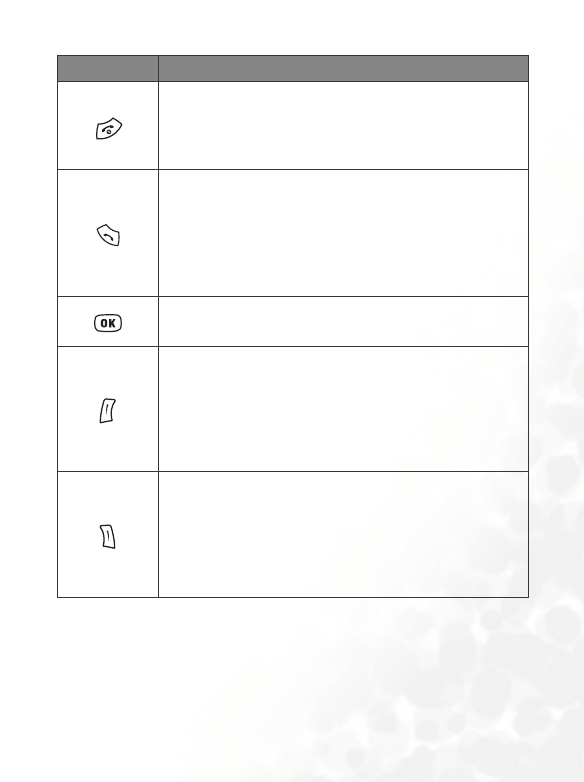
Getting to Know Your Phone 19
Key Commands and functions
Power on/off key
•Long-press to turn the phone on or off.
•Press this key to reject incoming calls or cancel a call
being dialed.
Send/Answer key
•Press to send or answer a call.
•Long-press and your phone will automatically call the
last number dialed.
•Press to access the list of last missed/dialed/received
calls.
OK key
•Press to open up the main menu and show its first item.
Left soft key
•Press to access the Phone Book (when PBook is
shown).
•Press to save the phone number keyed in from the
standby screen to the Phone Book (when Save is
shown).
Right soft key
• Press this key to use the camera function (when
Camera is shown).
•Press this key to delete entered digits one by one; long-
press to delete all digits entered (when Clear is shown).
•Long-press to turn the silent profile on or off.
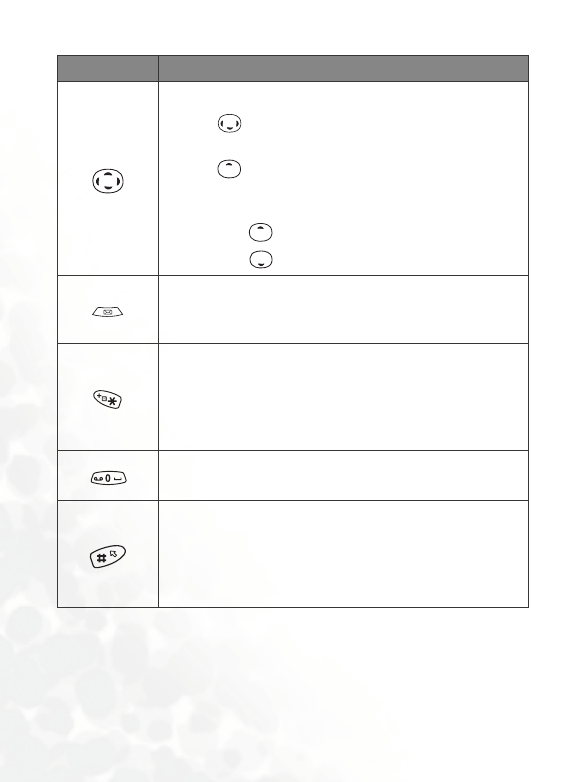
20 Getting to Know Your Phone
Scroll key
•Press to open the main menu and show its first
item.
•Press to enter the menu for function and phone
number shortcuts. For information about the shortcuts
menu, see page 57.
•Long-press to activate voice dialing.
•Long-press to activate the voice memo function.
Messages menu key
•Press this key to enter the Messages menu. For a
description of the Messages menu, see page 61.
Asterisk key
•Press this key to enter an asterisk " * ".
•To make an international call, long-press this key until
the display shows "+" ,Then enter the recipient's country
code, area code and phone number.
Voicemail key
•Long-press to dial your voicemail number.
# key
•Press to enter "#".
•For extensions: After entering a phone number, long-
press to enter a "P" and then enter the extension
number.
Key Commands and functions
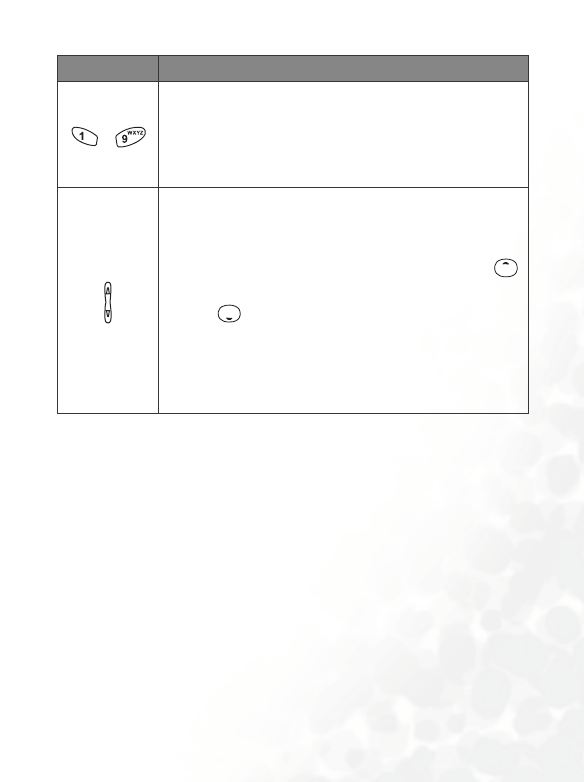
Getting to Know Your Phone 21
~
Alphanumeric keys
•Press to enter digits in a phone number.
•Shortcut key: Long-press a key to immediately access
the function, or dial the number, that it represents. See
page 57, "Shortcuts Menu".
Volu me key
•Long-press the upper or lower portion of this key,
located on the left side of the phone, to adjust the ring
tone volume. Press the upper portion of this key or
to increase the volume. Press the lower portion of this
key or to decrease the volume.
8When there is an incoming call, long-press the
upper portion of the volume key to reject the call;
long-press the lower portion to turn off the ring
tone.
Key Commands and functions
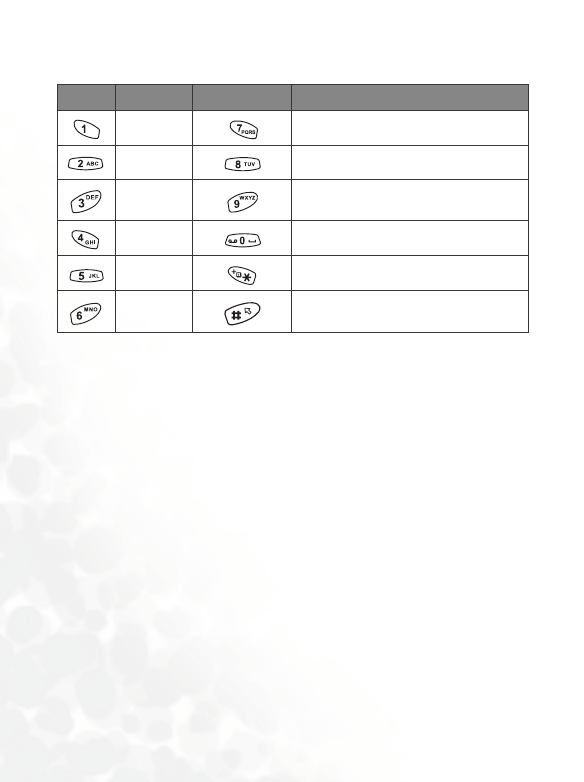
22 Getting to Know Your Phone
Alphanumeric keys
8Long-pressing an alphanumeric key will access the function it
represents, or dial the number that has been assigned to it (shortcut
function).
Key Digit Key Digit/Symbol/Function
17
28
39
40
5 * + (long-press)
6# P(long-press after entering
a phone number)
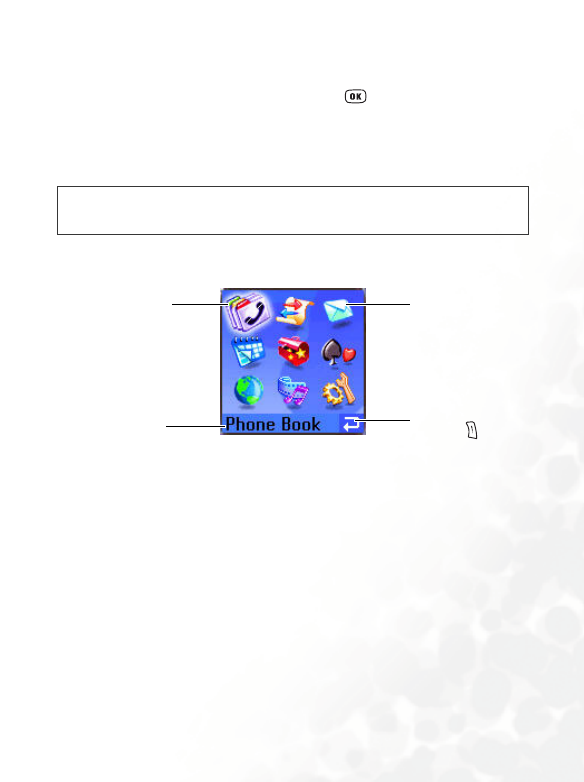
Getting to Know Your Phone 23
Menu Navigation
When the phone is in standby mode, press or to bring up the main
menu and highlight the first item in that menu: Phone Book.
8For details on how to use the various functions listed in the menu, see
page 92, "Menus".
Main menu
/You can choose a display color for the menus by going to the menu
Settings → Display → Theme. See page 150.
Indicates that
pressing will
return the
display to the
standby screen.
Each icon
represents a
sub-menu.
The main menu
item to which you
have scrolled will
be displayed as an
animation.
The name of the
main menu item
you have scrolled
to.
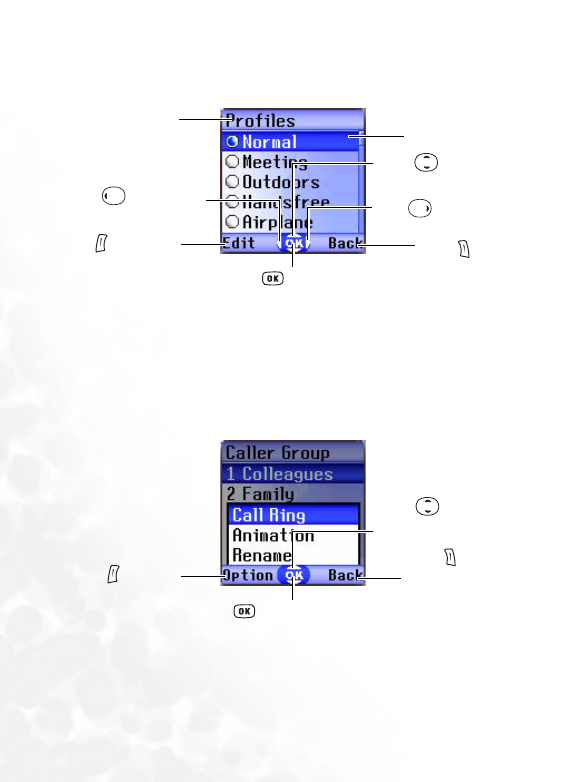
24 Getting to Know Your Phone
Sub-menus
Pop-up menus
Press to
return to the
previous menu
or screen.
Press to enter the
sub-menu represented
by highlighted item or
to activate the
highlighted function.
The highlighted
row is the currently
selected item.
The name of the
current menu.
Press to enter
the highlighted
menu item for
editing.
Press to scroll up or
down to an item.
Press to bring up
the previous screen. Press to bring up the
next screen.
Press to scroll up
or down to an item.
Press to enter the highlighted
item or activate the function
represented by the item.
Press to open a
pop-up menu.
Press to close a
pop-up menu.
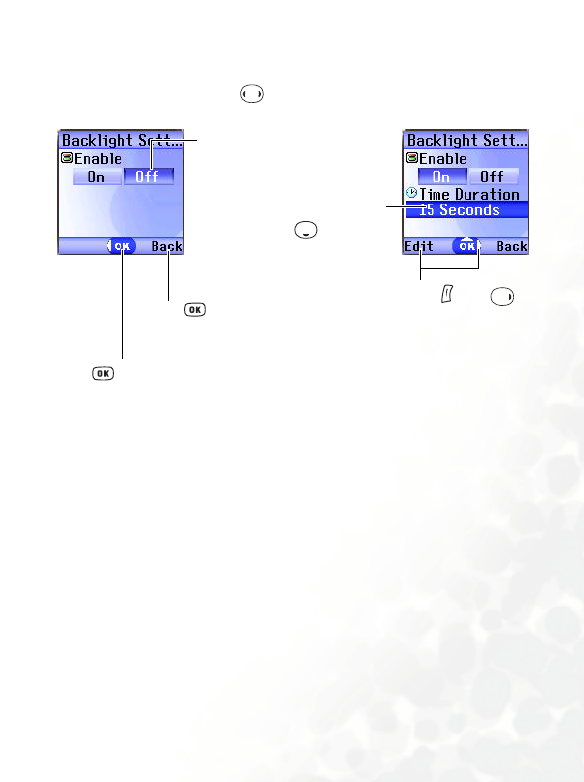
Getting to Know Your Phone 25
Turning a function on or off
Press to turn the selected
function on or off (the
currently selected function will
be highlighted).
After the selected function is
activated, the display will
usually show further setting
options. Press to scroll
to the desired setting option.
Press or
to edit the setting.
Press to confirm the
setting.
Press to cancel and return to the
previous screen.
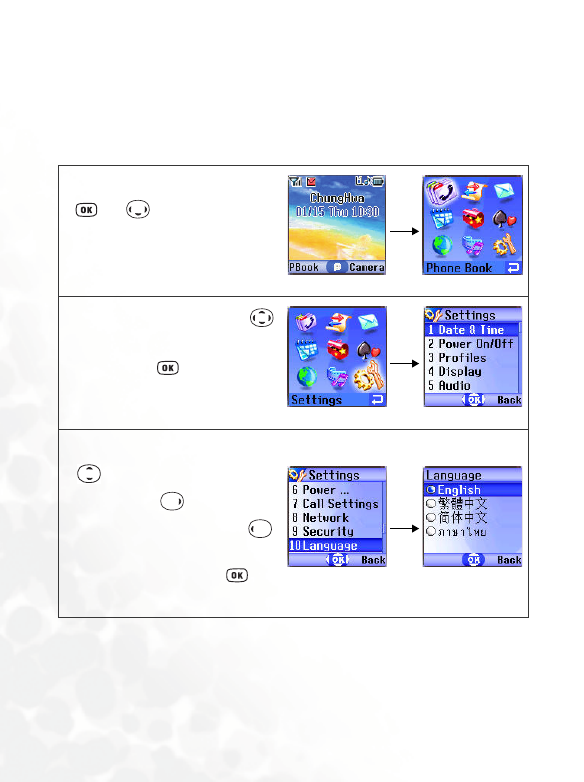
26 Getting to Know Your Phone
Menu navigation example
The example given below demonstrates how to use menus to change the
language setting.
Regular access
1.In the standby mode, press
or to open the main
menu.
2.In the main menu, press
to scroll to the Settings menu
icon. Press to enter this
menu.
3.In the Settings menu, press
to scroll to the Language
item (press to bring up
the next screen, or press
to bring up the previous
screen), then press to
enter the Language menu.
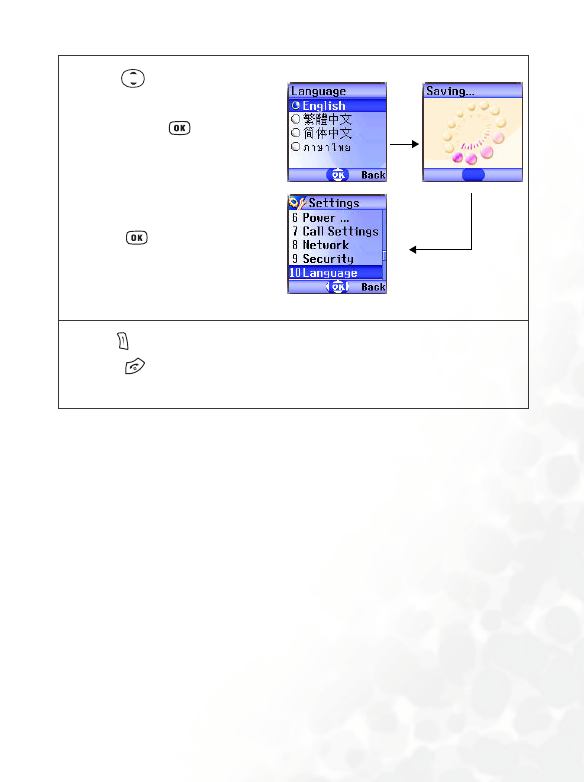
Getting to Know Your Phone 27
4.Press to scroll to the
language you wish to use.
Then press to confirm
your selection. If, for example,
you wish to set English as the
display language, scroll to
highlight English, and then
press . The display will
automatically return to the
Settings menu, displayed in
English.
5.Press (Back) repeatedly or
press once to return to
the standby screen.
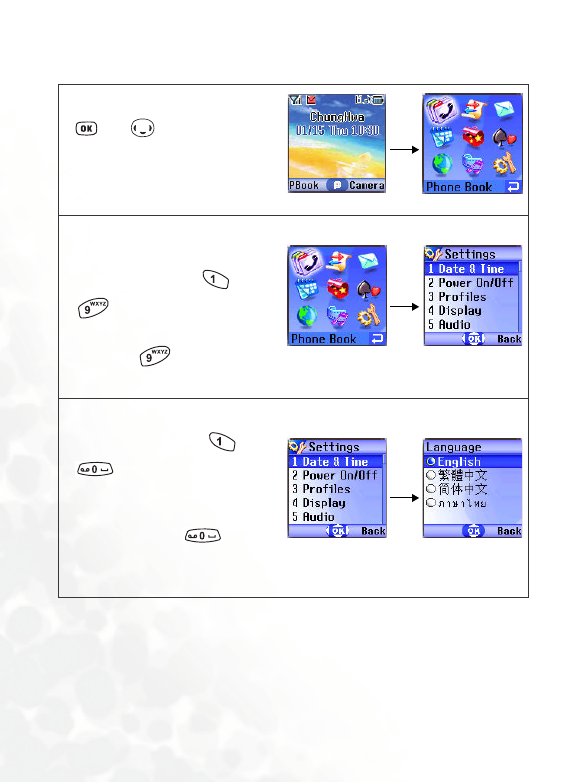
28 Getting to Know Your Phone
Access through number shortcuts
1.In the standby mode, press
or to bring up the
main menu.
2.The location of items in the
main menu corresponds to
the position of the to
keys in the
alphanumeric keypad. Thus,
pressing will bring up
the Settings menu.
3.In the Settings menu, the
alphanumeric keys to
represent menu items 1
to 10. Since Language is item
number 10 in the Settings
menu, pressing will
bring up the Language sub-
menu.
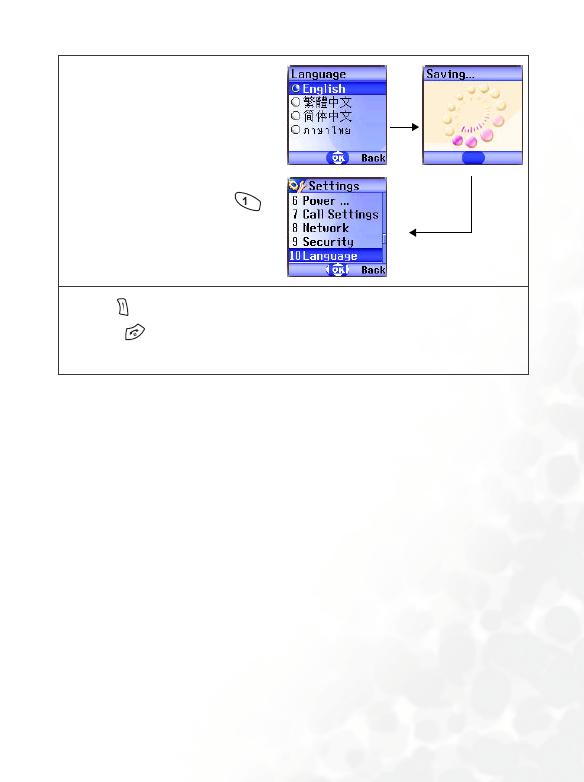
Getting to Know Your Phone 29
4.Press the alphanumeric key
that corresponds to the
language you wish to select, as
it is listed in the Language
sub-menu. For example, if
you wish to set English as the
display language, press .
5.Press (Back) repeatedly or
press once to return to
the standby screen.
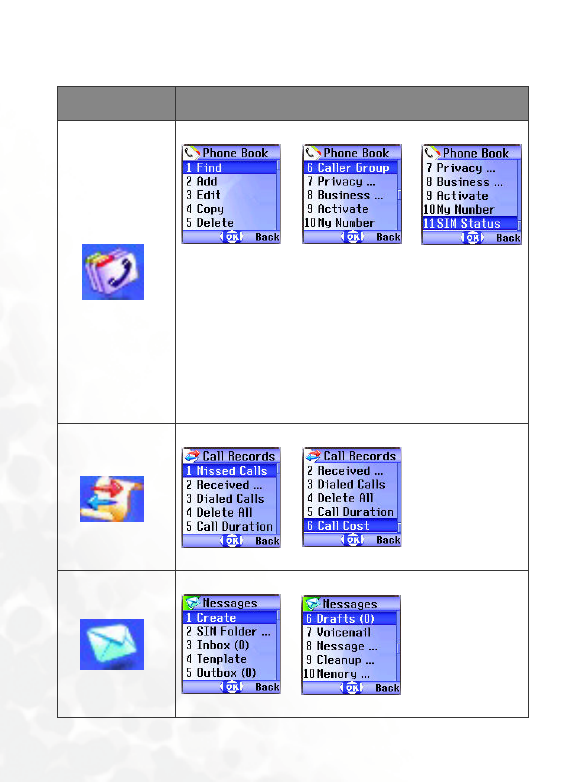
30 Getting to Know Your Phone
Main menu map
Select To enter
When using the
phone book
stored in your
SIM card's
memory, the
seventh item is
SIM Status.
There is no
Privacy
Manager item.
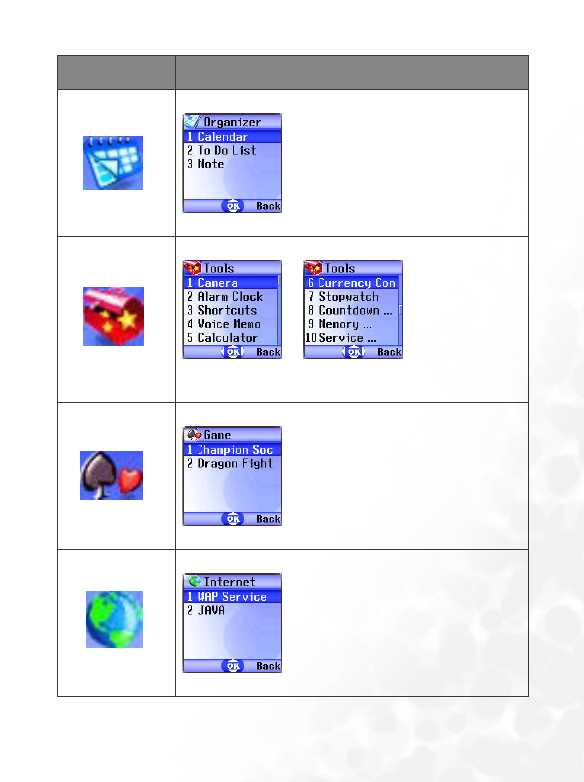
Getting to Know Your Phone 31
Select To enter
If your network
vendor provides
SIM toolkit value-
added services,
they will appear
as item number
11.
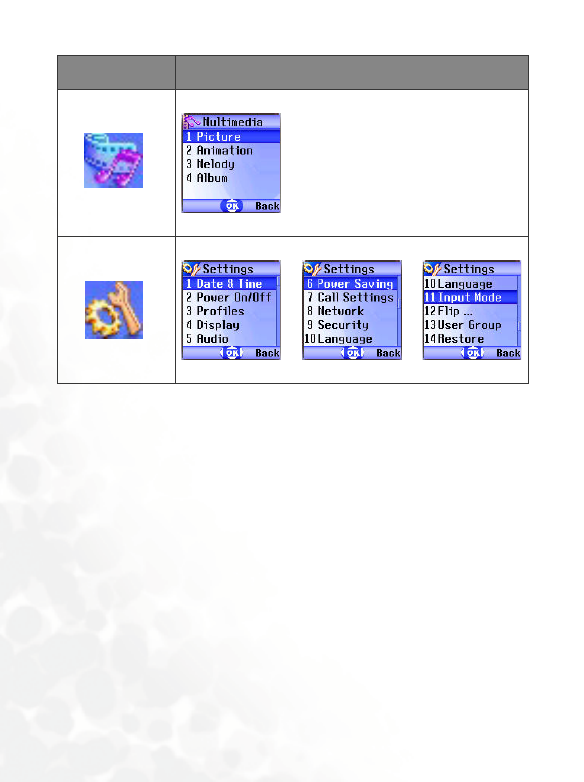
32 Getting to Know Your Phone
Select To enter
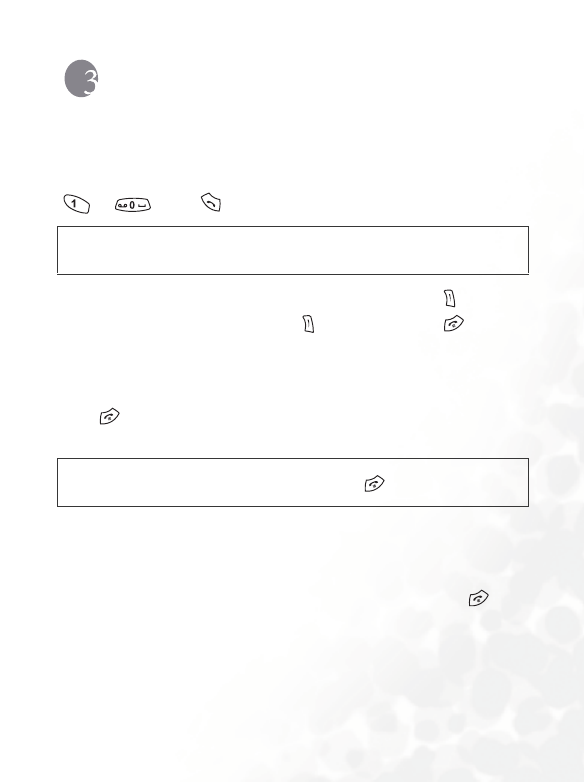
Using Your Phone 33
Using Your Phone
Making a Phone Call
Open the flip and make sure that the standby screen is shown on the
main display. Enter the desired number using the alphanumeric keys
to . Press to dial your call.
To modify a phone number that you have entered, press (Clear) to
delete individual digits. Long-press (Clear) or press to delete
all digits entered and return to the standby screen.
Ending a Phone Call
Press or close the flip to end a call. The display will show the total
call time, and then return to the standby screen.
8If the flip function has not been activated, you cannot end a call or
cancel dialing by closing the flip. To activate or cancel the flip
function, go to the menu Settings → Flip Activate.
8If you also have a call waiting or on hold, after you press , the
display will show a menu to allow you to choose the call you wish to
end.
/During a call, you can use the options. See page 49, "Call Menu".
/To cancel a call that is being dialed, press or close the flip.

34 Using Your Phone
Answering a Phone Call
When a call is received, your phone rings or vibrates, with the display
showing the caller's number (if supported by your network vendor). If
the caller is a contact stored in the Phone Book, the phone will show the
name recorded in the Phone Book.
Depending on whether your phone's flip is open or closed, you can do
one of the following to answer a call:
•If the flip is closed, opening it will allow you to answer the call.
8If the flip function has not been activated, you cannot answer a call by
opening the flip. To activate or cancel the flip function, go to the menu
Settings → Flip Activate.
•If the flip is already open, press to answer the call.
8If you wish to change the answering mode so that you can press any
key to answer a call, go the menu Settings → Profiles. After
selecting the currently active profile, press (Edit) and go to
Answer Mode → Any Key.
/•If the caller is a member of a caller group, the ring tone assigned to
this group will sound. The display will show the animation/image
that is associated with this group as well, to help you identify the
caller.
•If you have designated a particular ring tone and animation/image
for the caller, the phone will sound that ring tone and display that
animation/image, regardless of which caller group that caller
belongs to.
•For information on setting up a caller group, ring tone and
animation/image for contacts in the Phone Book, see page 38,
"Adding Contacts to the Phone Book".

Using Your Phone 35
Rejecting an Incoming Call
•Regardless of whether the flip is open or closed, you can reject an
incoming call by long-pressing the upper portion of the volume key
on the left side of the phone.
•When the flip is open, you can reject an incoming call by closing the
flip or pressing .
8If the flip function has not been activated, you cannot close the flip to
reject an incoming call. To activate or cancel the flip function, go to
the menu Settings → Flip Activate.
Turning Off the Ring Tone
for an Incoming Call
Regardless of whether the flip is open or closed, you can temporarily
mute the ring tone for an incoming call to avoid disturbing others. To
do this, long-press the lower portion of the volume key on the left
side of the phone. After the ring tone has been turned off, you can still
open the flip to answer the call.
Making an International Call
1. Enter the outgoing international call code, or long-press until
"+" appears on the display.
2. Enter the recipient's country code, area code and phone number.
Dial the call by pressing .

36 Using Your Phone
Making an Emergency Call
To call emergency services, enter 112 (the international emergency
number) and then press to dial the call. You can make an
emergency call even if your phone is locked or cannot access your
network, or there is no SIM card inserted, so long as you are within
range of a network of the type supported by your phone.
Dialing an Extension Number
After you enter a telephone number, long-press , The phone
display will show "P". At this point, you can enter the desired extension
number, and then press to dial it.
Speed Dialing
8You must assign a number key as the shortcut for a particular phone
number in order to use speed dialing for that phone number. For
information on how to set up a shortcut, see page 57, "Shortcuts
Menu".
After you have assigned a number key to serve as the shortcut key for a
particular phone number, you can long-press this key when the phone
is in the standby mode to dial the corresponding phone number. For
example, if you have selected as the shortcut key for a certain
phone number, long-pressing will dial this number.
Voi ce D i ali ng
1. In the standby mode, long-press .
2. After a beep, when the display shows the "Recording…" screen, you
can speak the voice dialing prompt for the number you wish to dial.
Once the phone has correctly identified the contact associated with
this voice dialing prompt, two situations may occur:

Using Your Phone 37
a. If there is only one phone number stored for the contact
identified, your phone will automatically dial this number.
b. If there are two or more phone numbers stored for the contact
identified, the display will show the contact's Phone Book data.
You can then scroll to the number you wish to dial, pressing
or to make the call.
8To use voice dialing to make a call, you must have stored a voice
dialing prompt for the desired number in Phone Book. For details, see
page 38, "Adding Contacts to the Phone Book".
Listening to Voicemails
When your voicemail inbox contains new messages, your network
vendor will send a text message notifying you that you have new
voicemail messages (if the network vendor supports it, the icons
and will be shown in the external and main display's status bars,
respectively. There are two ways to access and listen to voicemail:
1. When the phone is in standby mode, long-press to directly dial
the voicemail phone number and listen to your voicemail messages.
2. Go to the menu Messages → Vo i ce m ai l to dial the voicemail number.
8If the voicemail number is not stored on your SIM card or in the phone
itself, you will not be able to access your voicemail by long-
pressing ,Generally speaking, network operators will store the
voicemail number on a SIM card before giving it to you. If so, you will
be able to dial your voicemail number by long-pressing when
the phone is in standby mode, without needing to first manually store
this number. If however your network vendor did not store the number
on your SIM card, you will need to do this yourself. To save or modify
a voicemail phone number, go to the menu Messages → Message
Settings → Voicemail No.
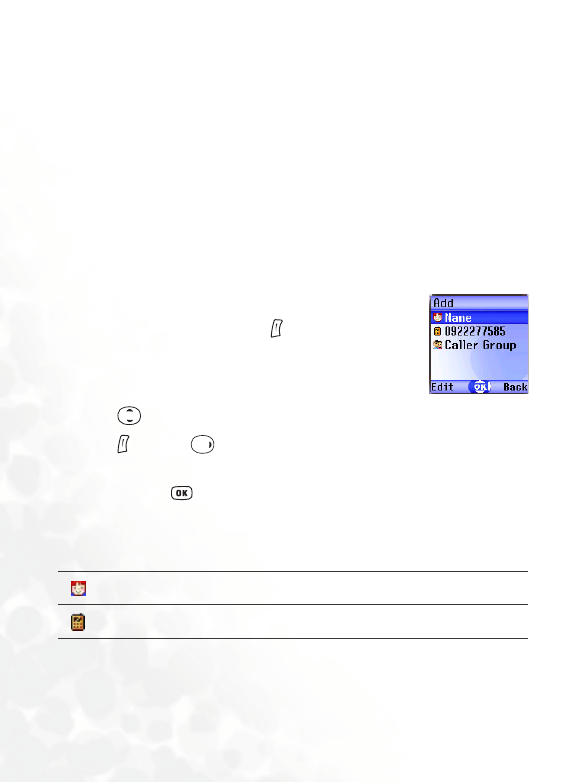
38 Using Your Phone
Phone Book
Adding Contacts to the Phone Book
The Phone Book will have different formats and data headings
depending on whether you have chosen to use a phone book stored on
your SIM card or in your phone's memory.
8The phone book in your phone's memory can store up to 500
contacts. The capacity of a phone book on your SIM card depends on
the particular service provided by your network vendor.
SIM card Phone Book
The data fields provided by a SIM card phone book are as follows:
The contact's name.
The contact's mobile phone number.
1. In the standby screen, enter the phone number that
you wish to store, then press (Save). The screen
will show the Phone Book data fields for a new
contact.
2. Press to scroll to the contact data field that you wish to edit.
Press (Edit), or simply begin keying in data to enter and
edit the currently selected field. After completing data entry and
settings, press to store the data for this contact.

Using Your Phone 39
Used to select a caller group for the contact. Press to select a
group and then press .
When there is an incoming call from this contact, the ring tone
assigned to this group will sound and the display will show the
animation/image associated with the group.
8To set a ring tone and animation/image for each caller group,
go to the menu Phone Book → Caller Group. See page 93.
8You can also go the menu Phone Book →Caller Group to
set a caller group for a contact.
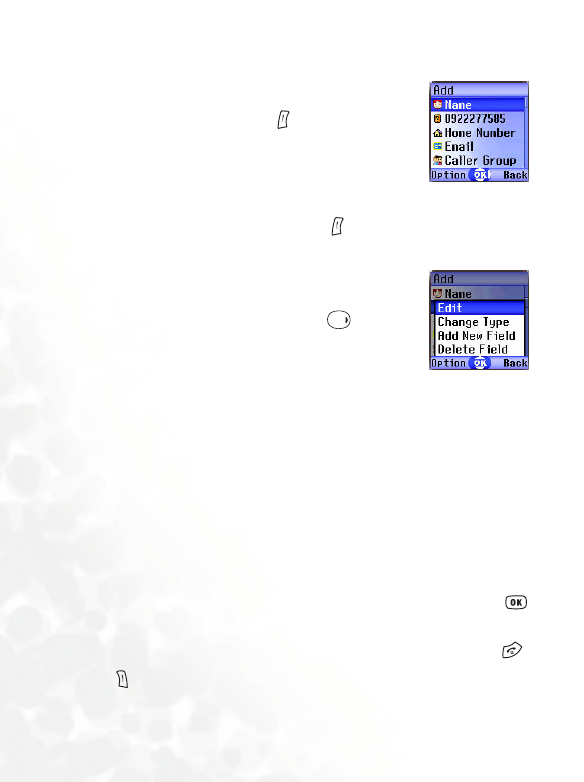
40 Using Your Phone
Phone Book in the phone's memory
3. After completing the data for the various fields, you must press
in order for the contact's data to be stored in the Phone Book.
8If you do not wish to save a modified Phone Book record, press
or (Back) to abort.
1. In the standby screen, enter the phone number you
wish to store, and then press (Save). The display
will show the default data fields for a new contact.
2. In the contact data screen, scroll to the data field
that you wish to edit, and then press (Options)
to bring up a pop-up menu. You can then use the
following options with the contact data:
•Edit: Edit the information in the selected field.
8In the contact data screen, press or begin
entering data to directly edit the data in the
currently selected field.
•Change Type: Change the category of the phone
number (for example, from Mobile Number to
Home Number). This option can only be used in the
phone number data field.
•Add New Field: Adds other data fields for a contact.
•Delete Field: Removes the selected data field.
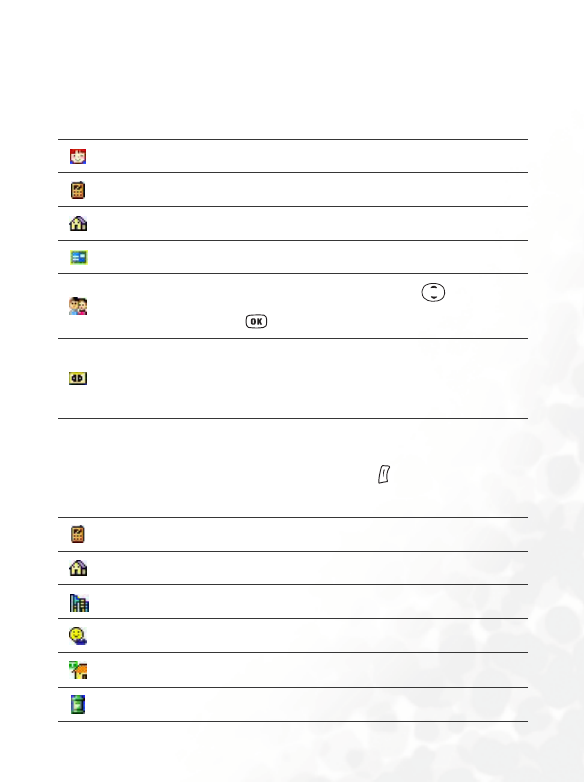
Using Your Phone 41
8You can also add a new contact by going to the menu Phone Book
→ Add.
•The default data fields for a contact are as follows:
•In addition to the contact data fields described above, you can also
add the data fields listed below by pressing (Option) when the
Phone Book screen is visible and then selecting Add New Field.
The contact's name.
The contact's mobile phone number.
The contact's home phone number.
The contact's e-mail address.
Used to assign a contact to a caller group. Press to select a
group, and then press .
Used to assign a voice dialing prompt to a phone number. After the
beep, speak the contact's name into the microphone. After it is
successfully recorded, the phone will play back this voice dialing
prompt.
The contact's mobile phone number.
The contact's home phone number.
The contact's work phone number.
Other phone number for the contact.
The contact's home address.
The contact's work address.
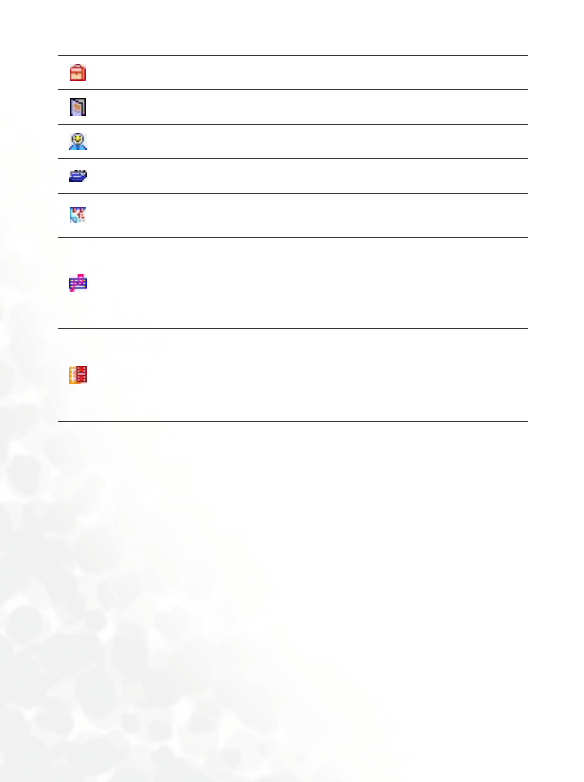
42 Using Your Phone
The contact's company name.
The contact's department name.
The contact's job title.
Used for notes about the contact.
Used to mark dates of special significance associated with the
contact.
Used to set a ring tone for the contact. When there is an incoming
call from the contact, the phone will play this ring tone.
8A ring tone set in this field will replace the one associated
with the contact's caller group, if any.
Used to set the photo that will appear on the phone's display when
there is an incoming call from the contact.
8The photo set in this field will replace the animation/image
associated with the contact's caller group, if any.
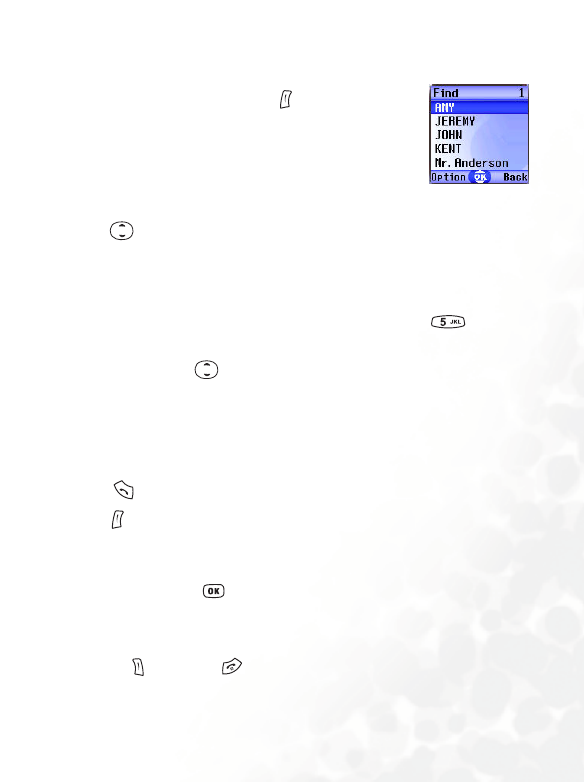
Using Your Phone 43
Finding Contacts in the Phone Book
There are two ways to locate a specific contact in the Phone Book:
•Press to scroll through the names (listed in alphabetical order)
until the one you want is highlighted.
•Press the alphanumeric key that corresponds to the first letter of the
name you wish to locate the appropriate number of times. For
instance, if the name starts with "K", you would press twice for
"K". The names starting with "K" will appear, with the first one
highlighted. Press to scroll to the name you want.
8You can also go to the menu Phone Book → Find, and then enter
the full name or the first letter of the name to locate a contact.
When the desired contact's name is highlighted, you can do one of the
following:
•Press to dial the first phone number saved in that contact.
•Press (Option) to bring up a pop-up menu, which contains the
following items:
Edit: Edit the Phone Book data for this contact. When you are
finished, press . For more information on editing, see page
38.
8If you do not wish to save a modified Phone Book record, press
(Back) or to abort.
In the standby mode, press (PBook) to
display contacts stored in the Phone Book.
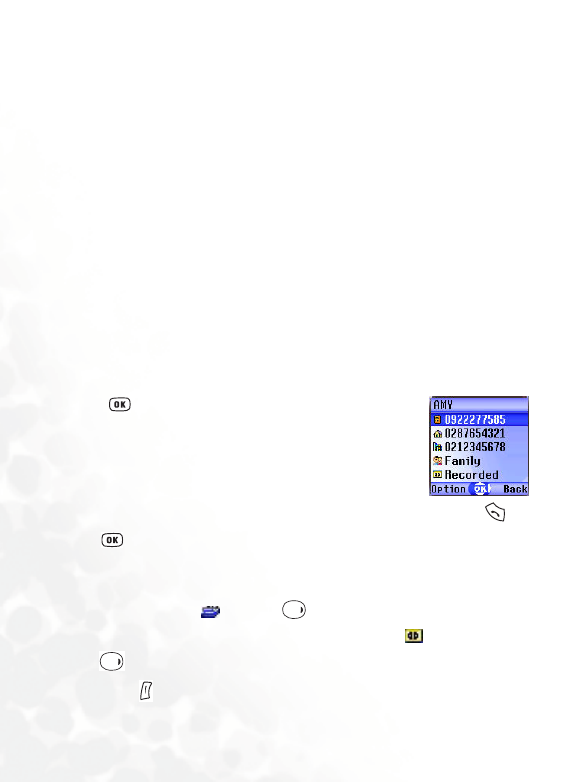
44 Using Your Phone
Copy to SIM (Phone): If you are currently using a phone book
stored in the phone's memory, you can copy the contact's data to
the phone book stored on your SIM card. Conversely, if you are
currently using a phone book stored on your SIM card, you can
copy the contact's data to the phone book stored in the phone's
memory.
8The only information that can be copied from a phone book
stored in the phone's memory to the one on your SIM card is a
contact's name, phone number, and caller group. If a contact has
more than one phone number associated with it, when that
contact's data is copied from the phone to the SIM card's phone
book, each phone number will be stored as separate contact.
Delete: Erases the contact's data from the Phone Book.
Send vCard: Attaches the contact's data to a message and send it
to others. For details on writing and sending a message, see page
63.
Scroll to the number that you wish to dial, and then press or
.
Scroll to the desired data field. If the complete contents cannot be
displayed on the screen, or there is no content to display (for
example, Note ), press to display the complete contents
(if the data field is for a voice dialing prompt , you can press
to play the sound of this voice dialing prompt.
Press (Option) to bring up a pop-up menu that contains the
following items:
•Press to show the information in all data fields
for that contact. You can then perform the following
tasks:

Using Your Phone 45
•Edit: Used to edit the Phone Book data for this contact. For
information on editing, see page 38.
8If you do not wish to save a modified Phone Book record,
press or (Back) to abort.
•Copy to SIM (Phone): If you are currently using a phone
book stored in the phone's memory, you can copy the
contact's data to the phone book stored on your SIM card.
Conversely, if you are currently using a phone book stored on
your SIM card, you can copy the contact's data to the phone
book stored in the phone's memory.
•Delete: Erases the contact's data from the Phone Book.
•Call: Dial the currently highlighted number.
Last Missed, Dialed, and Received Calls
There are two ways you can view the last missed, dialed, and received
calls on your phone, as well as information on their date and time:
1. If there have been any missed calls, the display will show a missed call
message along with the number of calls that were missed.
Press (View), and then press to scroll to the desired phone
number.
2. In the standby mode, press to view the list
of the most recent missed, dialed, and received
calls. Press to scroll to the desired phone
number.

46 Using Your Phone
8The icon will appear beside missed calls; the icon will
appear beside dialed calls; the will appear beside received
calls.
8If a phone number has already been stored in the information for a
contact in the Phone Book, the display will show the name of this
contact.
8If a call for the same number has been missed, dialed, or received
two or more times, a note such as "x02" will appear beside the record
of the call to show the number of times it was missed, dialed, or
received.
8If your network operator is not able to display a certain call's number,
the list will not show a number for the call.
When the number for a missed, dialed, or received call is highlighted,
you can perform the following tasks:
•Press to re-dial the number.
•Press (Option) to bring up a pop-up menu:
Call: Dial the phone number.
Save (Edit): If the phone number for the call has not been stored
in the Phone Book, select the Save option to create a contact for
this number in the Phone Book. If this phone number is already
stored under a contact in the Phone Book, select the Edit option
to edit this information for this contact. For information about
editing Phone Book data, see page 38, "Adding Contacts to the
Phone Book".
Delete: Erases the record of the call from the list.
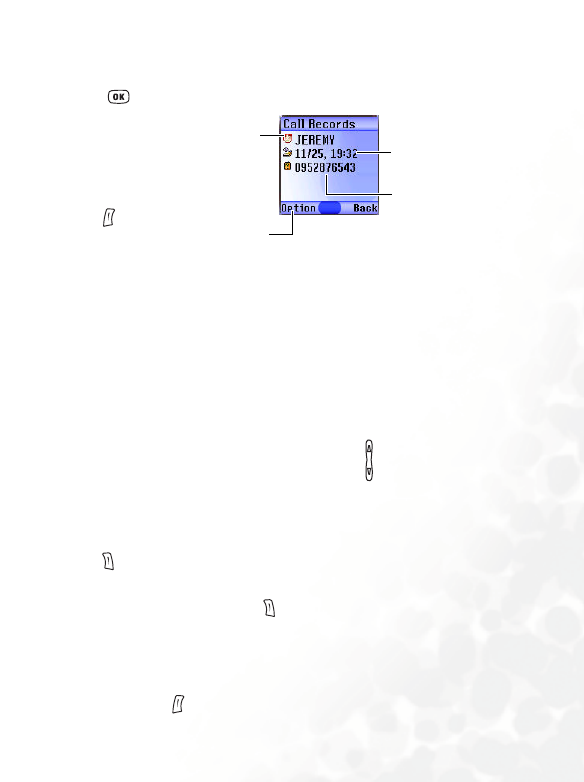
Using Your Phone 47
Delete All: Erases all the calls in the list.
Operations During a Call
8The following options marked with an asterisk (*) are dependent on
network support and may require a subscription.
Adjusting the Earpiece Volume
During a call, you can press the volume key on the left side of the
phone to adjust call volume.
Mute
Press (Mute) to turn off the microphone. The person on the other
end of the line will not be able to hear your voice. To restore the
microphone's function, press (Unmute).
Putting a Call on Hold*
1. When the only call is active:
a. Press (Hold) to hold this call.
•Press to display the details on this call.
This name of the contact for the
call (if the phone number has not
been stored in the Phone Book,
"Unknown" will be displayed.
The date and time of
the last time this call
was made.
The phone number
for the call.
Press (Option) to select
whether to dial the number, store
or edit it, or erase the record of the
call.

48 Using Your Phone
b. Press to end this call.
2. When the only call is on hold:
a. Press (Unhold) to resume the call.
b. Press to end this call.
3. When there is an active call and a call on hold.
a. Press (Swap) to resume the call that is on hold, and put
the active call on hold.
b. Press to show on the display a list of calls that you can
end.
Making a Second Call*
Enter a phone number, or select one from the phone number or call
record, and then press to dial it. The currently active call will
automatically be placed on hold. However, if there is already one active
call and another on hold, this action will fail.
Call Waiting*
If there is an incoming call while you are on the phone, a tone will
sound through the earpiece and the display will show that a second call
is currently waiting. You can handle the waiting call and currently active
call in the following ways:
1. Answer the waiting call: Press The currently active call will
automatically be placed on hold. However, if there is already another
call on hold, a menu will appear on the display allowing you to select
a call to end and then answer the waiting call.
2. Reject the waiting call: Press or (End). Pressing (End)
will immediately reject the waiting call; pressing will bring up a
menu on the display that you can use to select a call to end.

Using Your Phone 49
Call Menu
If you press during a call, it will bring up the call menu. Press
to scroll to the desired item (press to scroll through the menu page
by page) and then press to enter that item; press (Back) to
return to the pervious menu; press to return directly to the call
menu.
8Items marked with an asterisk (*) depend on network support and
may require a subscription.
Phone Book
Accesses data in the Phone Book. For details, see page 38, "Phone
Book".
Call Records
Allows you to view information on missed, received, and dialed calls.
See page 45, "Last Missed, Dialed, and Received Calls".
Conference*
Conference calls allow you to converse with more than one party at a
time. The conference menu contains the following options:
8The maximum number of parties that can be accommodated during a
conference call depends on the particular service provided by a
network vendor.
Hold/Unhold/Swap*
Toggles the call status.

50 Using Your Phone
Join/Private
Adds a party that is on hold to the current conference call, or
isolates a single party in a conference call and puts all other parties
on hold.
Forward
Allows two parties to connect, while ending one's own call (one of
the two parties may be involved in an active call while the other is
either on hold or being dialed), so as to allow the two parties to
have their own call.
Send DTMF
When the phone is connected with other devices or services, you can
send DTMF (Dual Tone Modulation Frequency) strings. DTMF strings
are keypad tones that can be sent via the microphone as you dial
another number. Your phone will emit the tones in order to
communicate with answering machines, pagers, computerized
telephone services, and so forth.
Enter the phone number and then press to send the DTMF string.
End Call
End All
Ends all calls, whether active or on hold.
End Active
Ends only the active call.
End Hold
Ends only a call or calls on hold.

Using Your Phone 51
End One
Ends only a single call.
Hold/Unhold/Swap
Toggles the call status.
Mute/Unmute
Activates/cancels the silent mode.
SMS
Enters the SMS (Short Message Service —i.e. text message) menu. For
details on the SMS menu, see page 61, "Messages Menu".
Calculator
Allows you to use the calculator. For information about the calculator,
see page 108.
STK
Brings up the menu for the STK (SIM Toolkit) services provided by
your network vendor.
Using the Silent Profile
From the standby screen, you can long-press to activate the Silent
profile. Once it is activated, the phone will alert you to an incoming call
by vibrating with no ring tone.
•When you long-press to activate the Silent profile, the phone will
vibrate for one second. The icon will appear in the main display's
status bar (the external display will show ) to remind you that
your phone is currently using the Silent profile.
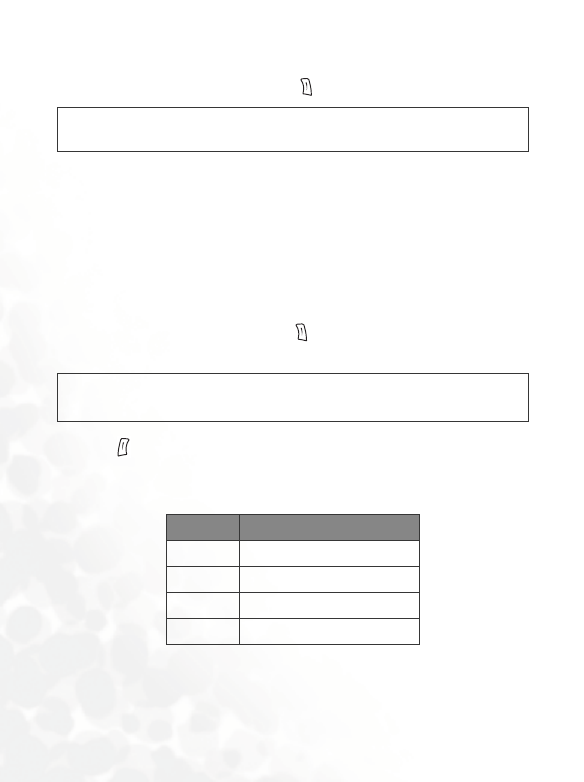
52 Using Your Phone
•To cancel the Silent profile and restore the previously active vibrant
and ring tone settings, long-press .
8To set and select a profile, please enter the main menu's Settings →
Profiles. See page 146.
Camera Function
You can take photos using your phone's embedded camera, and then set
photos as wallpapers for the main display's standby screen, or send
them to others through MMS.
1. From the standby screen, press (Camera), which will bring up
the view finder.
2. Press (Option) to make the following settings for the camera:
•Resolution: Sets the desired resolution for photographing. You
have the following resolution values to choose from:
8The Face Mask option below will not be available if resolution is
set to Low (i.e. 80 x 60).
/This feature is very convenient for switching to the Silent profile
during, say, a meeting to avoid the disruption caused by a ring tone.
/You can also use the camera by going to the menu: Tools →
Camera.
Option Represented Resolution
High 640 x 480
Medium 320 x 240
Low 160 x 120
Lowest 80 x 60
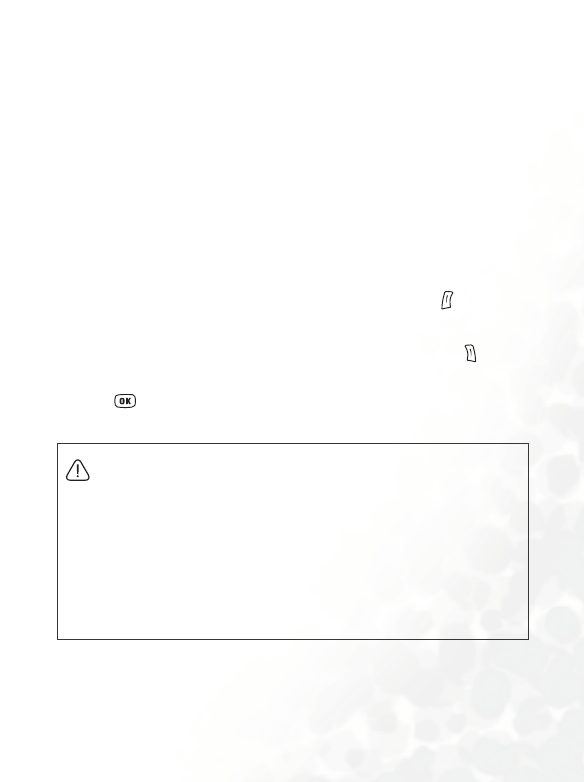
Using Your Phone 53
•Light Condition: Based on the light conditions of the
environment selected in this option, the camera will
automatically adjust the its color balance in order for you to take
best-quality pictures.
•Free Space: Shows the amount of remaining available memory
for storing photos.
•Face Mask: After you have selected this option, the camera's view
finder will display a mask that is used to position the face of the
person being photographed in good focus, in order for you to
later obtain the best results when changing the person's facial
expressions using the Face Morph function. See page 55 for
details. To cancel the Face Mask function, press (Option),
and then select Normal Preview.
3. After you have completed necessary camera settings, press (Back)
to return to the view finder screen, and when your object is in focus,
press to photograph the object. Its photo will then show up on
the main display.
Please note the following while shooting photos
•The external camera does not have a flash. Please take photos in a
well-lit area.
•When taking photos, do not block or touch the camera lens on the
back of the phone.
•Always photograph your object with the source of light behind you.
•Do not shake the phone when taking photos.
•Please be sure that the lens is perfectly clean before taking photos.
Use a soft cloth to wipe the lens if it is not clean.

54 Using Your Phone
4. Press (Save) to save this photo to the menu: Multimedia →
Album. If you are not satisfied with this photo, press (Back) to
take a new photo. After you have saved a photo to the phone's
memory, you can manage this photo using the options below:
•Send Photo: This option enables you to send this photo to others
through MMS. You can also do so by either selecting the menu:
Messages →Create → MMS, or by selecting Multimedia →
Album. For details on using the MMS function, see page 66.
•Set to Wallpaper: Designates this photo as the wallpaper for the
main display's standby screen. You can also do so by using the
menu: Multimedia → Album, or by using Settings → Display →
Wal lp aper → Photo. See page 139 and page 150.
•Set to Phonebook: You can use this photo as a phone book
contact's visual caller ID. When there is an incoming call from
that contact, the phone's display will show this photo.
New Entry: Enables you to create a new contact in the Phone
Book using the photo as her/his caller ID.
Exist Entry: Uses this photo as an existing contact's caller ID.
Select the contact you want and press to attach the photo
to that contact.
8This function is only available for contacts saved in the phone
memory's phone book. Please go to the menu: Phone Book →
Database to select the Phone Book for use.
•Rename: Give this photo a new file name.
8A photo's name can't be left empty, nor can it share the same
name with another photo already stored in your phone.
•Details: Shows the photo's name, date, resolution, and file size.
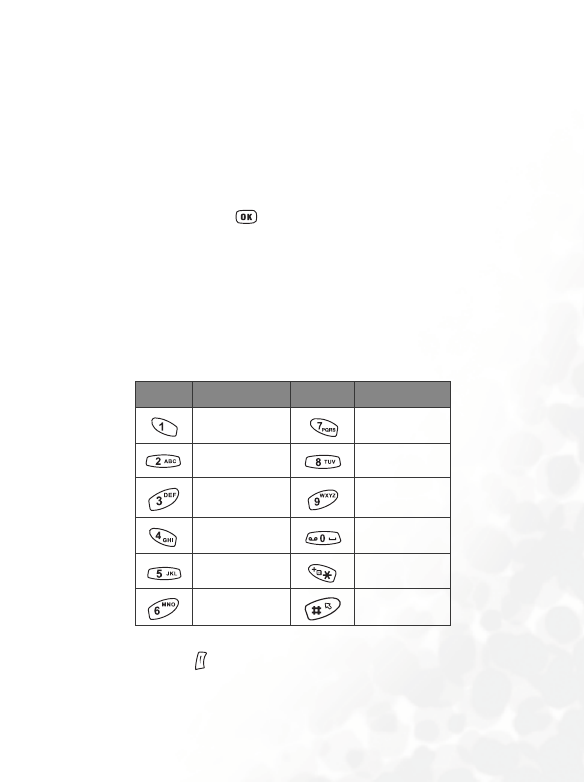
Using Your Phone 55
•Face Morph: If you have activated the Face Mask option before
photographing someone, after a photo is taken and saved, you
will be able to change her/his facial expression shown in the photo
with this Face Morph feature, and then save photos showing
different expressions of the same person.
Please follow the steps below to perform the Face Morph
function:
a. After pressing to select the Face Morph option, the
screen will show "Press number key to change," and then
will bring up the original photo with the person's face
remaining unchanged. At this point, you can press a
corresponding number key to generate the desired facial
expression effects for the person's face. The chart below
shows each number key and their matching expression
effects:
8Press (Normal) to show the original photo without any
expression effects added.
Key Expression Key Expression
Smile Angry
Young Funny
Slim Alien
Kiss Koala
Sleepy Monkey
Sad Fox
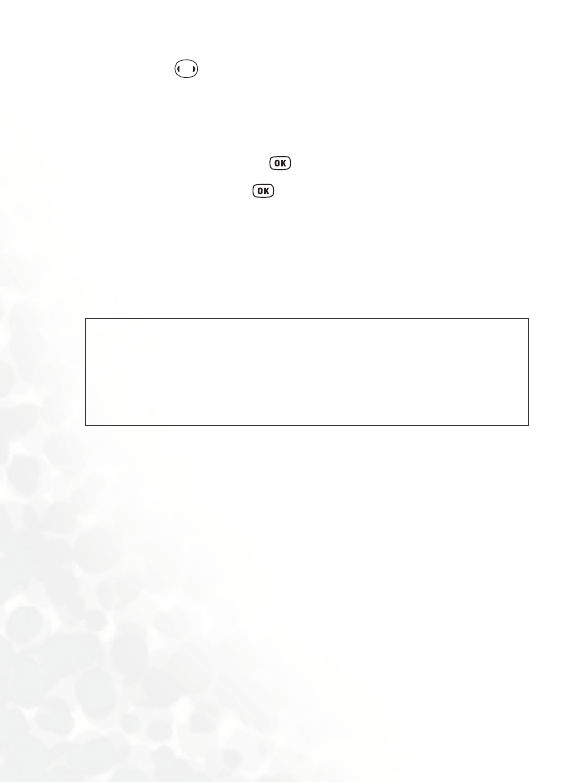
56 Using Your Phone
b. Press to intensify/reduce expression effects. Intensity
levels will be displayed at the top right corner of the screen
ranging from 1 to 5; the default value is 3.
c. When the photo shows desired expression effects for the
person's face, press , enter this new photo's file name,
and then press to save this photo to the menu:
Multimedia → Album.
d. After you have saved the photo showing the expression
effects you want, the original photo will reappear. Again, you
can press corresponding number keys to create more photos
showing various facial expressions.
/•You can also go to the menu: Multimedia → Album to
configure expression effects for faces shown in the saved
photos. See page 139 for details.
•The Face Morph function may not create desired outcomes
when used to change your pets or dolls' facial expressions.
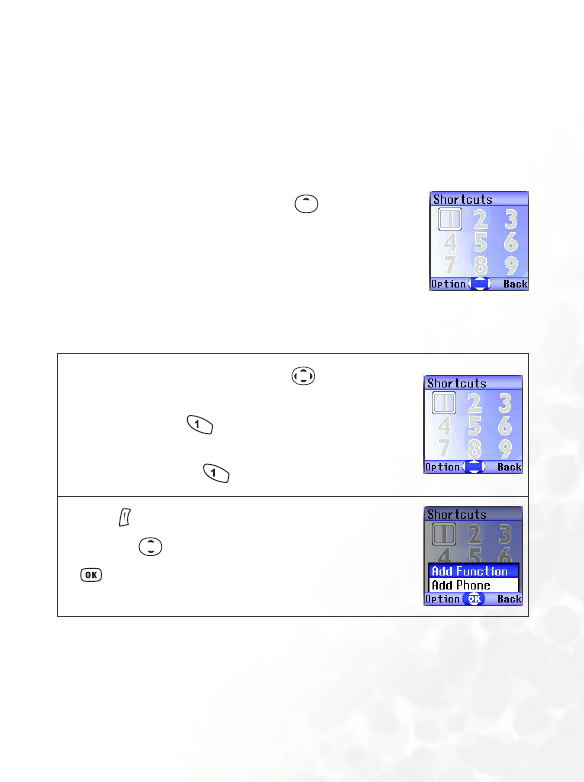
Using Your Phone 57
Shortcuts Menu
You can use the Shortcuts menu to assign 9 alphanumeric keys as
shortcuts to commonly used functions or frequently dialed numbers.
(The screen will show preset shortcuts, if any.)
Entering the Shortcuts Menu
Setting Function Shortcuts
1. In the Shortcuts menu, press to move the
selection box to the number key you wish to use as
a shortcut key ( is selected in the example on
the right). You can also press the actual
alphanumeric key to select it.
2. Press (Option) to bring up a pop-up menu,
and use to select Add Function. Then press
.
From the standby screen, press to enter the
Shortcuts menu. The numbers 1 to 9 displayed in the
menu's default screen represent the corresponding 9
alphanumeric keys on the phone.
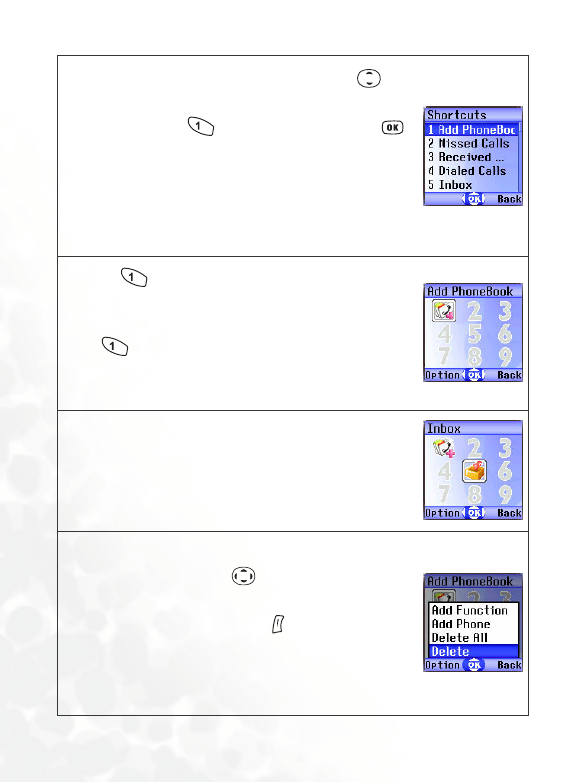
58 Using Your Phone
3. From the Add Function menu, press to
select the function to be represented by the
shortcut key , and then press .
Alternatively, you can press a corresponding
alphanumeric key to select the function you want.
8The functions listed in the Add Function menu
are selected from various other menus. For
details on these functions, see page 92, "Menus".
4. After has been set as the function shortcut
key, the '1' icon in the shortcut menu screen will
be replaced by the icon for the function assigned
to . The top of the screen will display the
name of the function currently assigned to this
key.
5. Repeat the above step to add or modify function
shortcut key assignments.
6. To cancel a shortcut key and restore the key's
original function, use to move the selection
box to the icon for the shortcut key that you wish
to cancel, and then press (Option). Select
Delete to cancel the shortcut.
8If you select Delete All, all shortcut settings will
be cancelled.
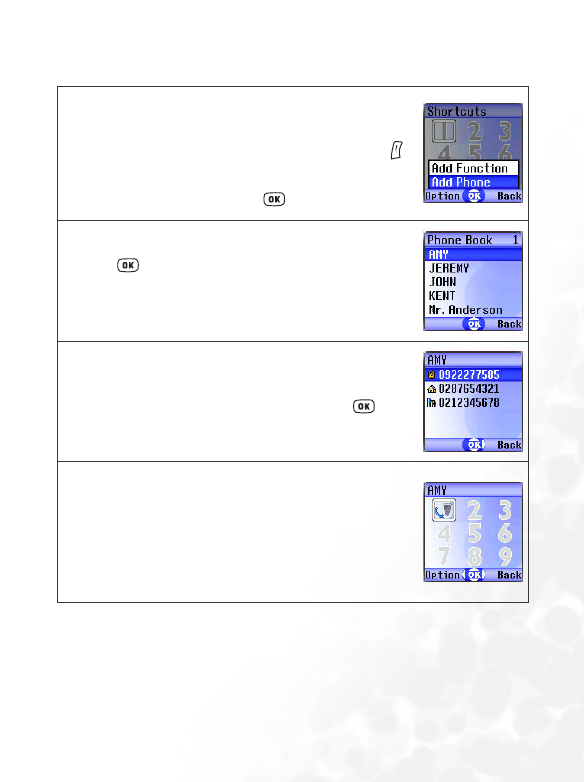
Using Your Phone 59
Setting Phone Number Shortcuts
1. The method for setting a phone number shortcut
key is largely the same as for a function shortcut
key. After selecting the shortcut key, press
(Option) to bring up a pop-up menu. After
selecting Add Phone, press to confirm.
2. From the Phone Book, select a contact, and then
press .
3. Next, from the list of phone numbers for this
contact, select the one that you wish to access
through the shortcut key, and then press .
4. After you have set the shortcut key, the number
icon for the key will be replaced by an icon
representing a phone number shortcut. The upper
part of the screen will display the name of the
contact to whom the phone number accessible by
the shortcut key belongs.
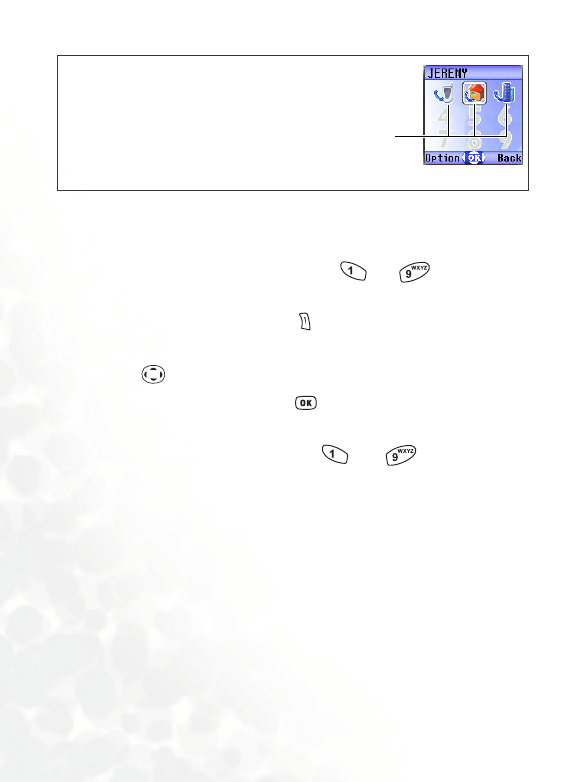
60 Using Your Phone
Using Function and Phone Number Shortcuts
There are two ways to use shortcuts:
1. From the standby screen, long-press to to access the
function represented by that key or dial the number it represents.
2. From the standby screen, press (GoTo) to enter the Shortcuts
menu. You can then:
a. Press to move the selection box to the icon corresponding to
the desired key. Then press to access the assigned function
or dial the assigned phone number.
b. Press the corresponding key to to access the
function represented by that key or dial the number it represents.
5. Repeat the above step to add or modify a phone
number shortcut.
Different categories of phone
numbers will be represented by
different phone number shortcut
icons.
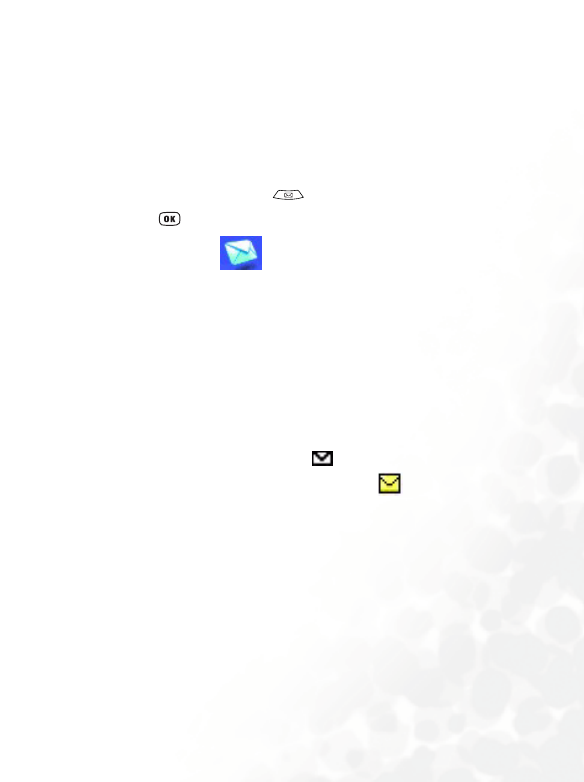
Using Your Phone 61
Messages Menu
Besides SMS (Short Messaging Service) and EMS (Enhanced Messaging
Service), your phone also supports MMS (Multimedia Messaging
service). EMS allows your to insert simple graphics and ring tones in
your message, while MMS enables you to send photos, colored images
and music using your phone.
From the standby screen, press to enter the Messages menu. You
can also press when in the standby screen and then enter from the
main menu by selecting .
Yo u can u s e t his Messages menu to read, edit and send SMS, EMS and
MMS messages.
Additional information about messaging
•Memory for storing messages is divided between SIM card memory and
the phone's own memory. In the first level of the Messages menu, except
for the SIM Folder option, messages saved in Inbox, Outbox, and Drafts
are all stored in the phone's memory.
•When a new message is received, or when there are unread messages in
the phone's or SIM card's memory, the icon will appear in the external
display's status bar; the main display will show the icon in its status bar
to remind you that you have unread messages.
•When a message has arrived, it will be saved either to the the phone's
memory or to your SIM card's memory, depending on the preferred
memory you have selected in the menu: Messages → Message Settings
→ Short Message Settings → Save New Msg To (See page 79).
Messages saved to the phone's memory will be stored in the menu:
Messages → Inbox; messages saved to your SIM card's memory will be
stored in the menu: Messages → SIM Folder → Inbox.
•If the phone's memory is already full, any new messages will remain stored
in the SIM card's memory (in the menu Messages → SIM Folder →
Inbox) until the SIM card's memory is itself full.

62 Using Your Phone
•If there is a flashing icon on the external display, and the main display
shows a red icon , this means that the SIM card's message memory is
full. When the SIM card's memory is full, your phone will not be able to
receive any new messages. If this has occurred, when you go to the
Messages menu, the display will show a "SIM Full!" message to remind
you of the current situation.
•If the number of messages stored in the phone's memory has reached 500,
when you enter the Messages menu, the "Message Full!" screen will
appear. If there is less than 1K remaining in the phone's memory, the
"Memory Insufficient!" screen will appear. In either of these two situations,
any messages received will be saved to the SIM card, and you will no
longer be able to edit any messages.
•If there is less than 50K remaining in the phone's memory, you will no
longer be able to edit any MMS messages; if the amount of the phone's
remaining memory is less than that required to save an incoming MMS
message, the phone will not be able to receive that message.
•In the Messages menu, the number (such as "(1)", "(3)") following the
name of each message folder represents the number of messages saved
in that folder.
The items in the Messages menu are as follows:
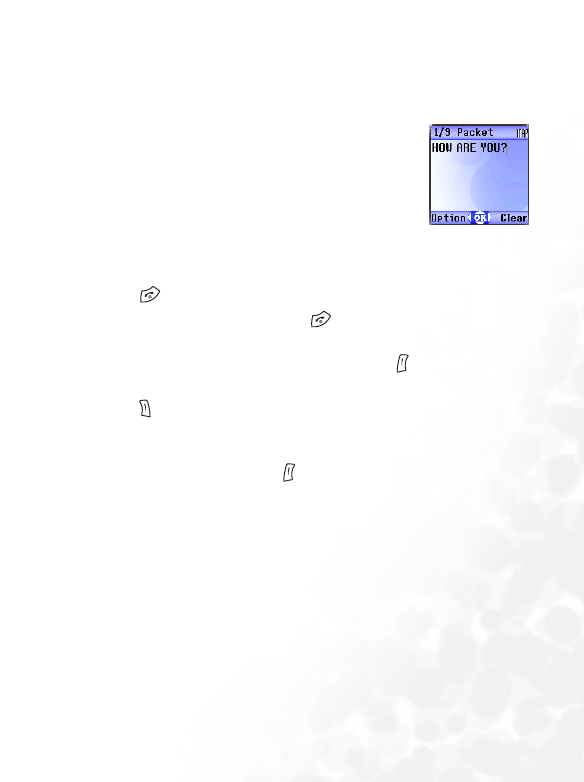
Using Your Phone 63
Create
Short Message
2. When writing a message, press (Option) to perform the following
tasks:
•Insert: You can insert the following types of objects:
Te x t : This is a list of templates that can be used instead of entering
all the characters individually. You can use the factory default
templates or templates of your own that you previously saved to
the list.
8To create your own quick message templates, go the menu
Messages → Template →SMS Template. See page 77.
1. Used to bring up the message editing screen so you
can write a new SMS/EMS message. Use the
alphanumeric keys to enter text.
8For information on how to use the input methods
provided by the phone for writing messages, see
page 86, "Input Modes".
8If no text has been entered in the editing screen,
press to return to the standby screen; if some
text has been entered, pressing will bring up
the prompt "Back to Idle?", to make sure you wish
to abort the message being edited. If you press
(Yes), you will return to the standby screen; if you
press (No), you can continue writing the
message.

64 Using Your Phone
Picture: You can select an EMS icon from the EMS icon library to
insert into your message. Press to select the name of the icon
you wish to insert, and then press (View) to view the icon.
Press to insert the icon into your message.
Animation: You can select an EMS animation from the EMS
animation library to insert into your message. Press to select
the name of the animation you wish to insert, and then press
(View) to view the animation. Press to insert the
animation into your message.
Melody: You can select an EMS ring tone from the EMS ring tone
library to insert into your message. When the recipient of the
message reads it, the inserted ring tone will be played by the
recipient's phone. Scroll to the name of the ring tone you wish to
use, and then press to insert the ring tone into your message.
The inserted ring tone will be displayed as musical note within
the message's text.
vCard: You can select a contact's data from your Phone Book to
attach to your message. After receiving your message, the
recipient can save the attached contact data to their own Phone
Book.
vCalendar: You can select a Calendar memo and then attach it to
your message. After receiving your message, the recipient can save
this attached memo to their own Calendar.
•Text A l ignme n t : Used to select the type of text alignment for the
message's content.
/You can insert an EMS icon or animation at any position within a
message's content.

Using Your Phone 65
3. After you have finished editing the message, press . A screen in
which you can edit the recipient's number will appear. There are two
ways you can enter the recipient's phone number:
•Key in the recipient's phone number in the number editing screen.
•Before entering any phone number, you can press (Select) and
then select a recipient from the list of contacts in the Phone Book.
Follow the steps below:
a. Press to scroll to the name of contact, and then
press (Select) to select that contact.
b. The display will show all the phone numbers stored for
the contact you selected. Press (Select) to select the
desired phone number.
8If the number is too long, press to display the
complete number.
c. After the number has been selected, you must press
to return to the list of contacts in the Phone Book. A
check mark will appear beside the contact whose
number you selected as recipient for your message. You
can use the same steps to select the numbers of other
contacts.
d. After you have selected all the numbers you wish to dial,
press and the display will show all these numbers.
4. After the numbers to be dialed have appeared on the screen, press
to use the following options with this message:
•Send Message: Sends the message to the numbers selected previously.
8When a message is to be sent, a copy of the message will be saved
to the Outbox folder. If the save fails, the "Save to Outbox Failed!"
screen will appear and the send operation will stop.
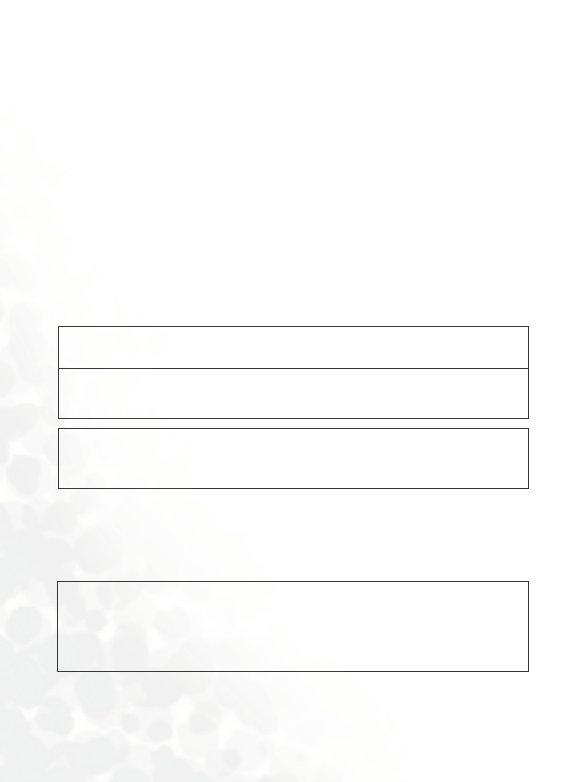
66 Using Your Phone
•Preview: Allows you to view the contents of the message.
•Save to Draft: Saves the message to the Drafts folder, for sending at a
later time.
•Edit Content: Allows you to edit the contents of the message.
MMS
You can edit and send MMS messages using this menu.
8Before you start to use MMS, you have to subscribe to both GPRS
and MMS services provided by your operator. Then you have to
adjust MMS settings in your phone to be able to use MMS.
Because MMS uses your operator's MMS server on a GPRS network
to send messages to phones, you need to adjust the following
settings correctly in order to use MMS:
Editing and sending MMS messages
1. Access the menu: Messages → Create → MMS to open up the MMS
editing screen. You can now edit the first page of your MMS message:
2. Edit text: Enter text into the first page's editing screen.
Internet →WAP Service → WAP Settings, and select the MMS server
you wish to activate in order to configure its settings.
8For information on configuring an MMS server's settings, see page
125, "WAP Settings".
Messages → Message Settings → MMS Settings → Server Info, and
select the server you want to use for sending and receiving MMS
messages.
/•An MMS message can be made up of multiple pages.
•You can also compose an MMS message using a preset MMS
template by going to the menu: Messages → Template → MMS
Template. See page 77 for details.

Using Your Phone 67
3. Insert objects: You can insert various types of objects into an MMS
page. From the editing screen, press (Option), and then select
Insert. The types of objects you can insert into an MMS page are as
follows:
•Animation: Scroll to highlight the file name of the desired
animation, and then press (View) to display this animation.
After entering the viewing mode, you can press to display the
next/previous animation; pressing will display the animation
in full screen. Finally, press to insert the selected animation
into the page you are editing.
•Picture: After scrolling to highlight the file name of the picture
you want, you can press (View) display this picture. After
entering the viewing mode, pressing will display the next/
previous picture; pressing will display the picture in full
screen. Press to insert the selected picture into an MMS page.
•Photo: You can select a photo saved in the Album menu to insert
into an MMS page.
Scroll to the file name of the desired photo, and then
press (View)to view this photo. After entering the viewing
mode, pressing will display the next /previous photo. Press
to insert the photo into the page you are currently editing.
•Voic e M emo : Select the file name of the voice memo to be
attached to an MMS page. When the desired voice memo's name
is highlighted, press (Option) and then select Send to attach
this memo to the page you are editing.

68 Using Your Phone
•Melody: You can select a ring tone saved in the phone to insert
into an MMS page. Scroll to highlight the file name of the desired
ring tone, and then press to insert this ring tone to the MMS
page.
8Each MMS page is only able to accommodate one image and
one audio file. If you insert another image or audio file into the
same page, the newly inserted file will replace the existing one.
8After an audio file such as a voice memo or a ring tone is
inserted into an MMS page, the icon will appear on the top of
that page.
•Tex t: You can select a text template to insert into the message
instead of entering all the characters individually. You can use the
factory default templates or templates of your own that you
previously saved to the template list.
8To create and save your own text templates, go to the menu:
Message → Template → SMS Template. See page 77.
•New Photo: Enables you to shoot a new photo using the phone's
camera and then insert that photo into the currently edited page.
4. When you have completed your message's first page, from this page's
screen press (Option), and then select Insert → Page Before/
Page After to add a new page before or after the existing one. You can
then repeat the steps described above to compose that newly added
page.
5. When you are editing an MMS page, you can also press (Option)
to perform the following tasks:
•Preview: Plays all of the pages you have created in sequence.
•Remove Picture: Removes an image or photo from the currently
displayed page.